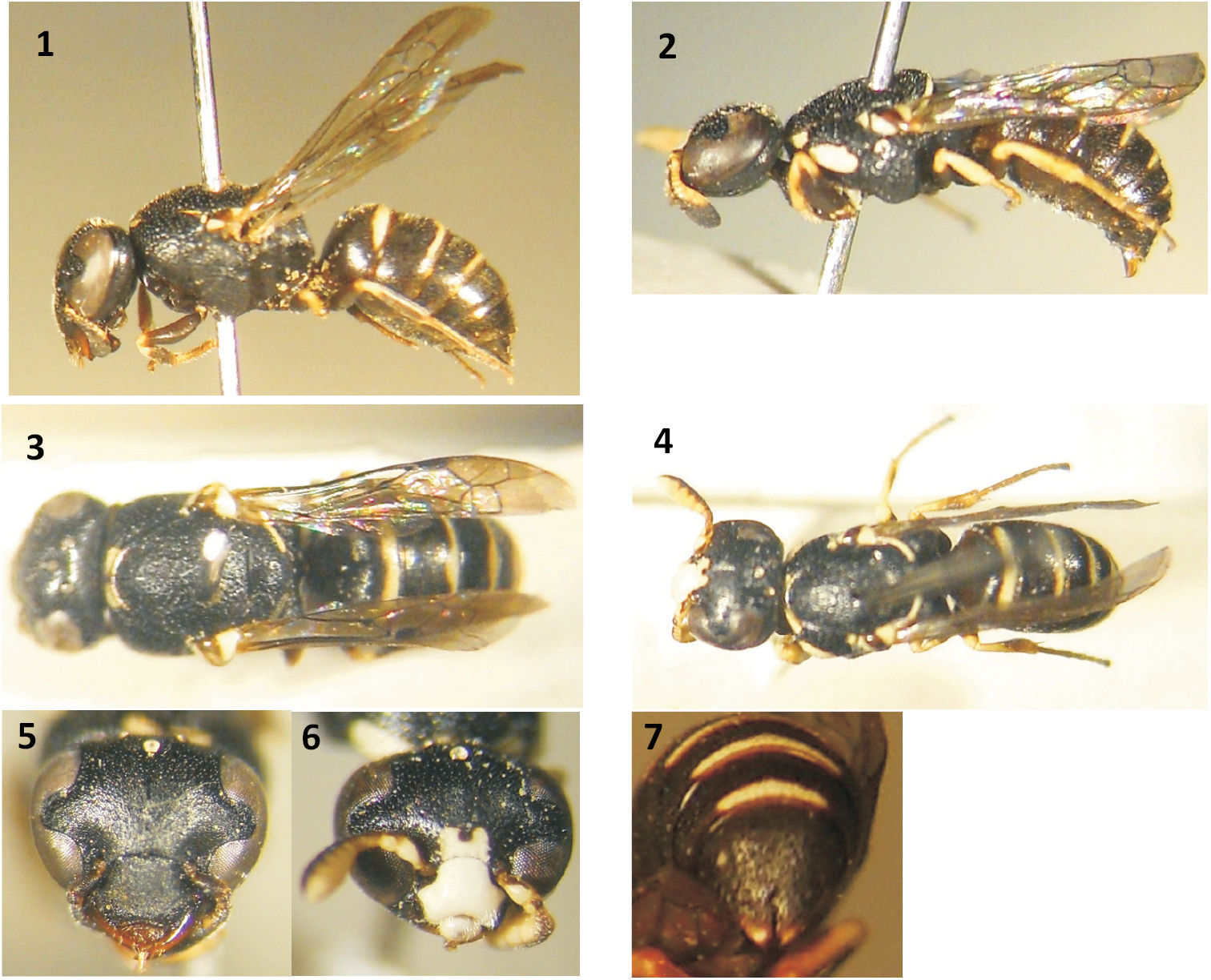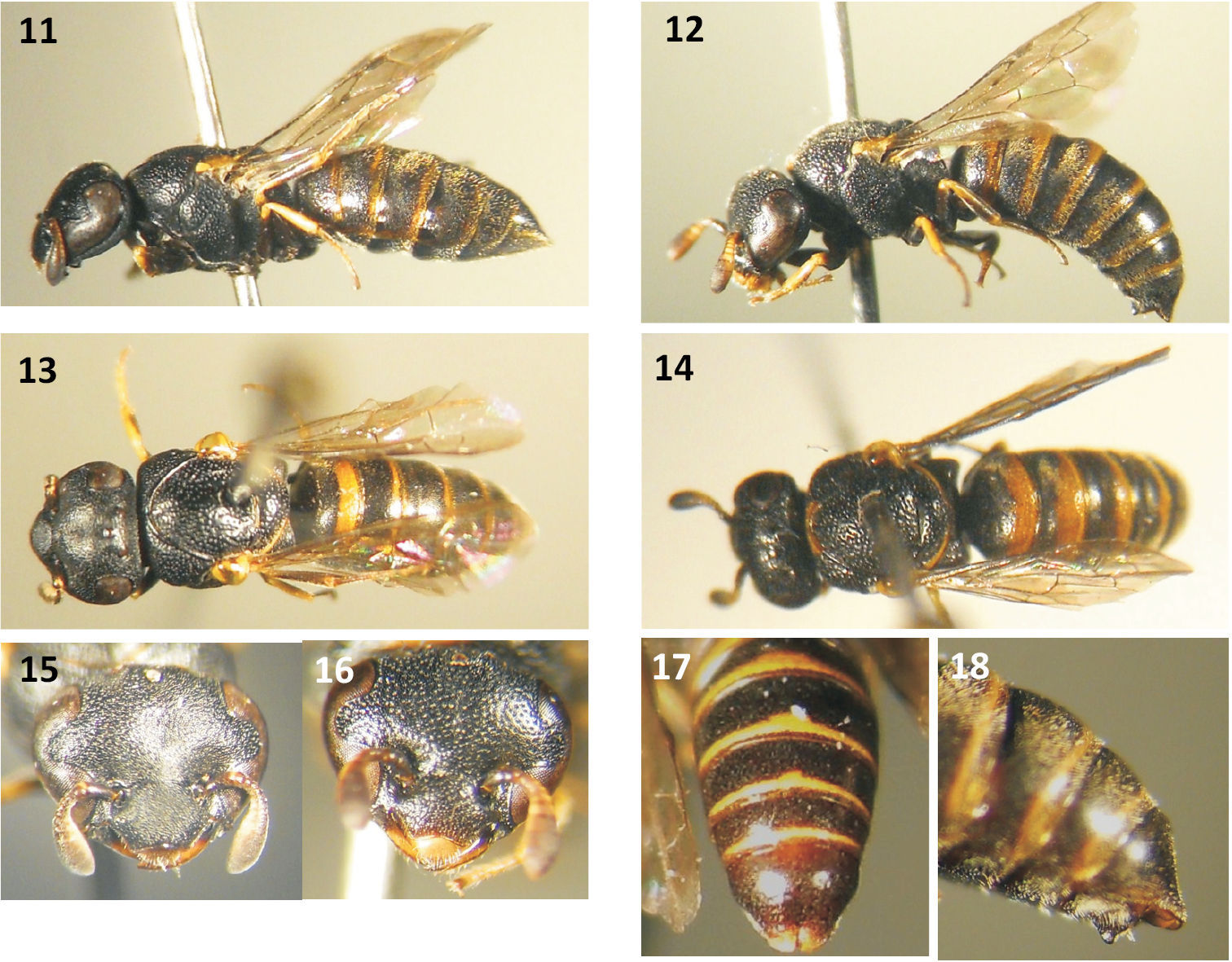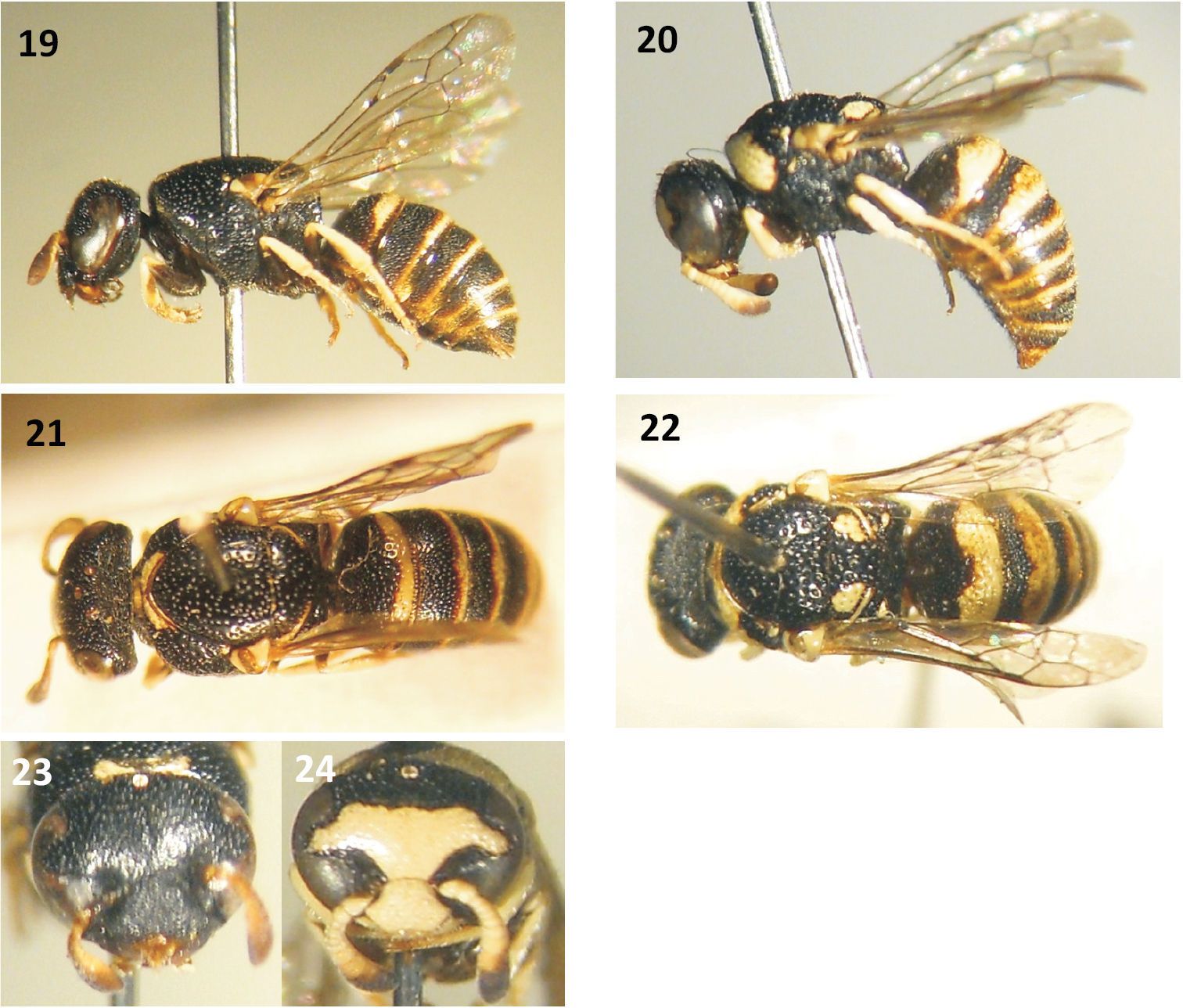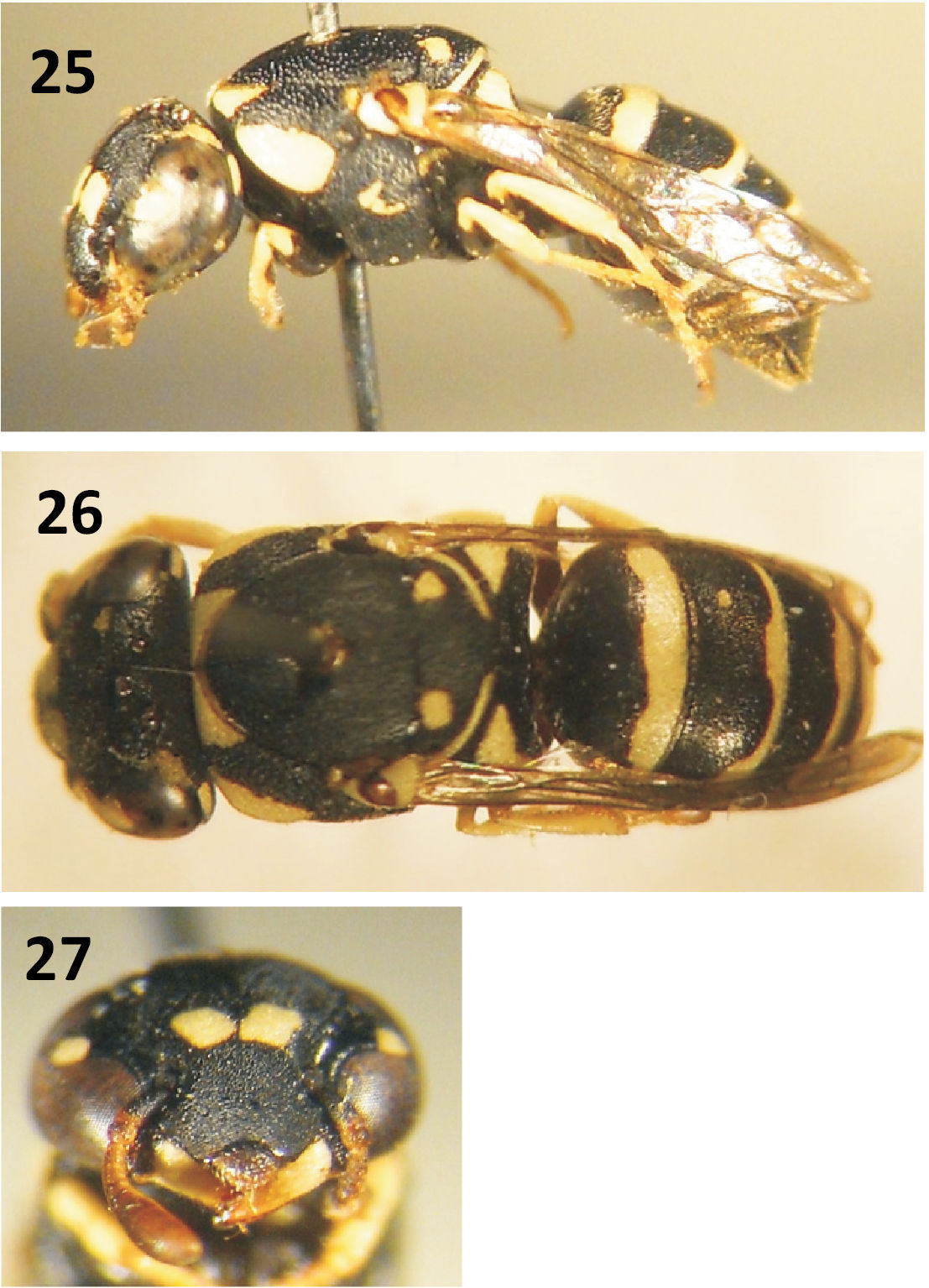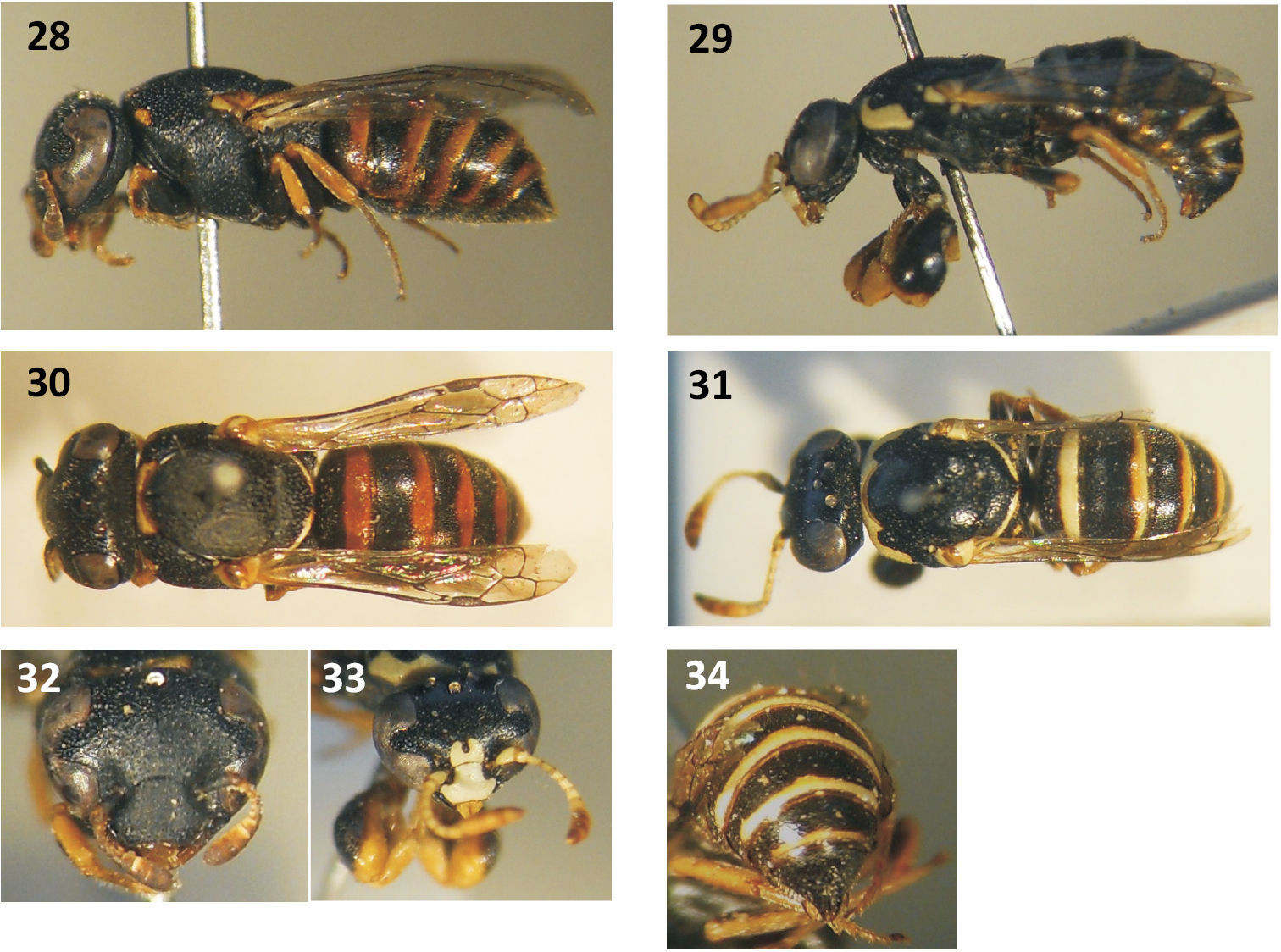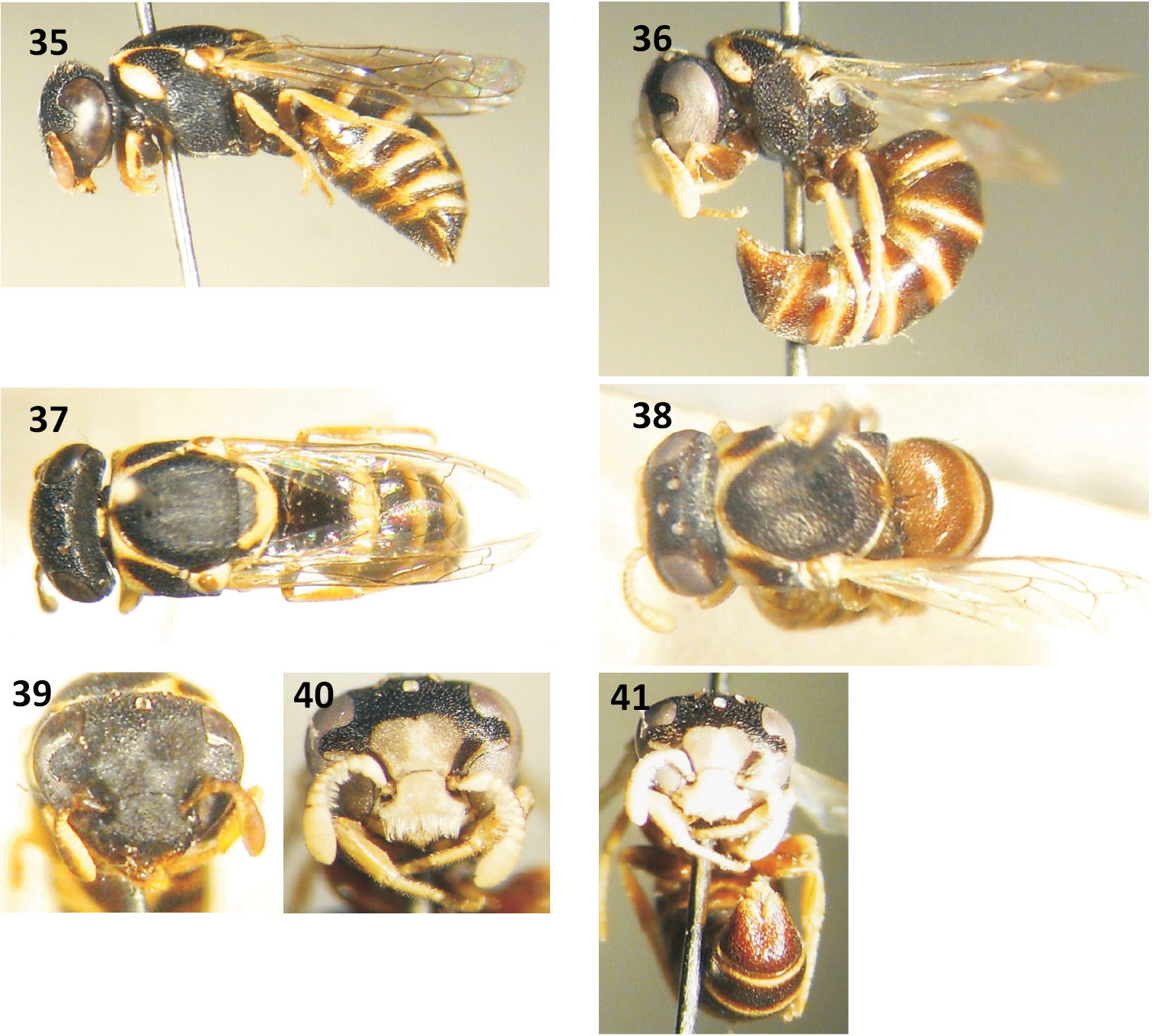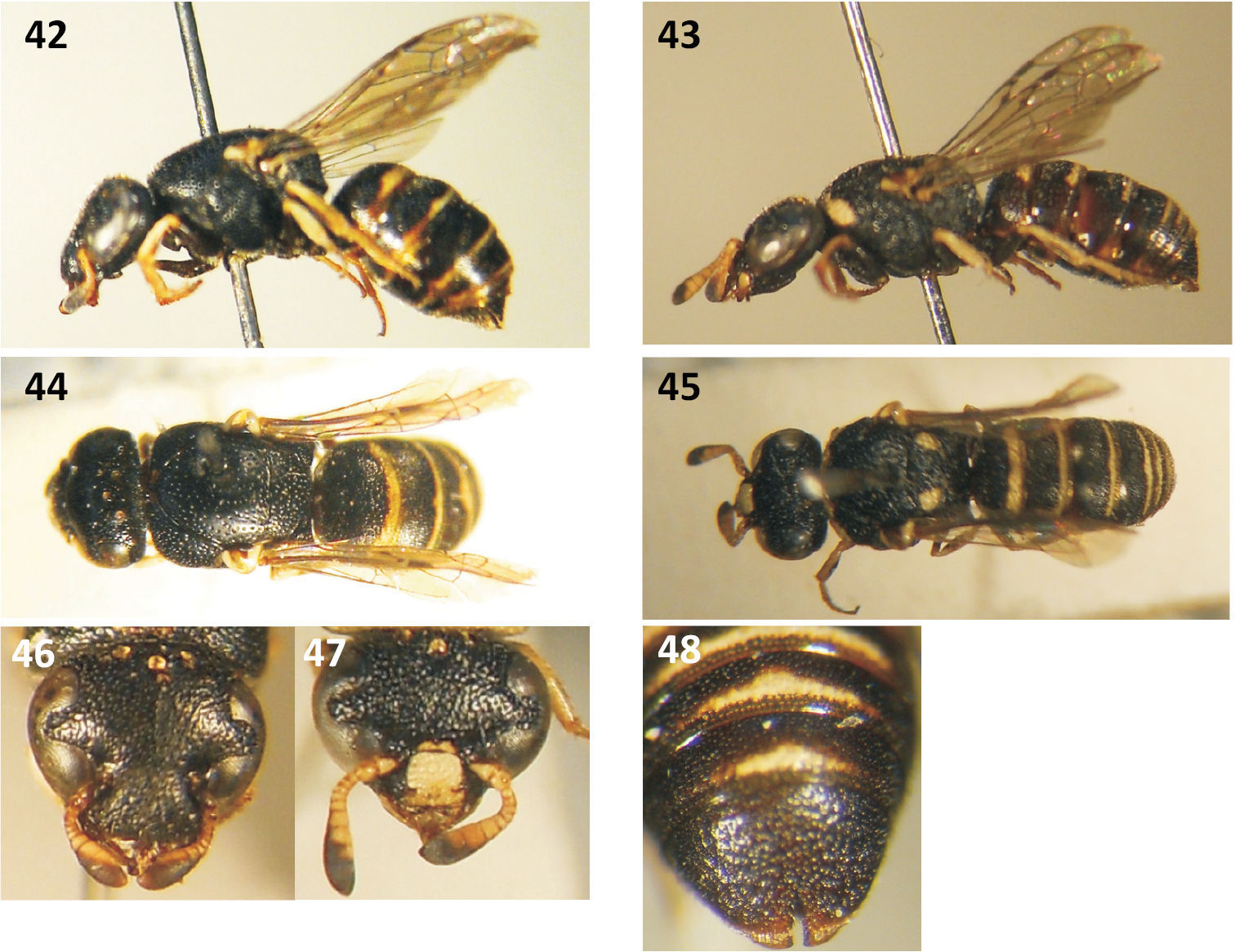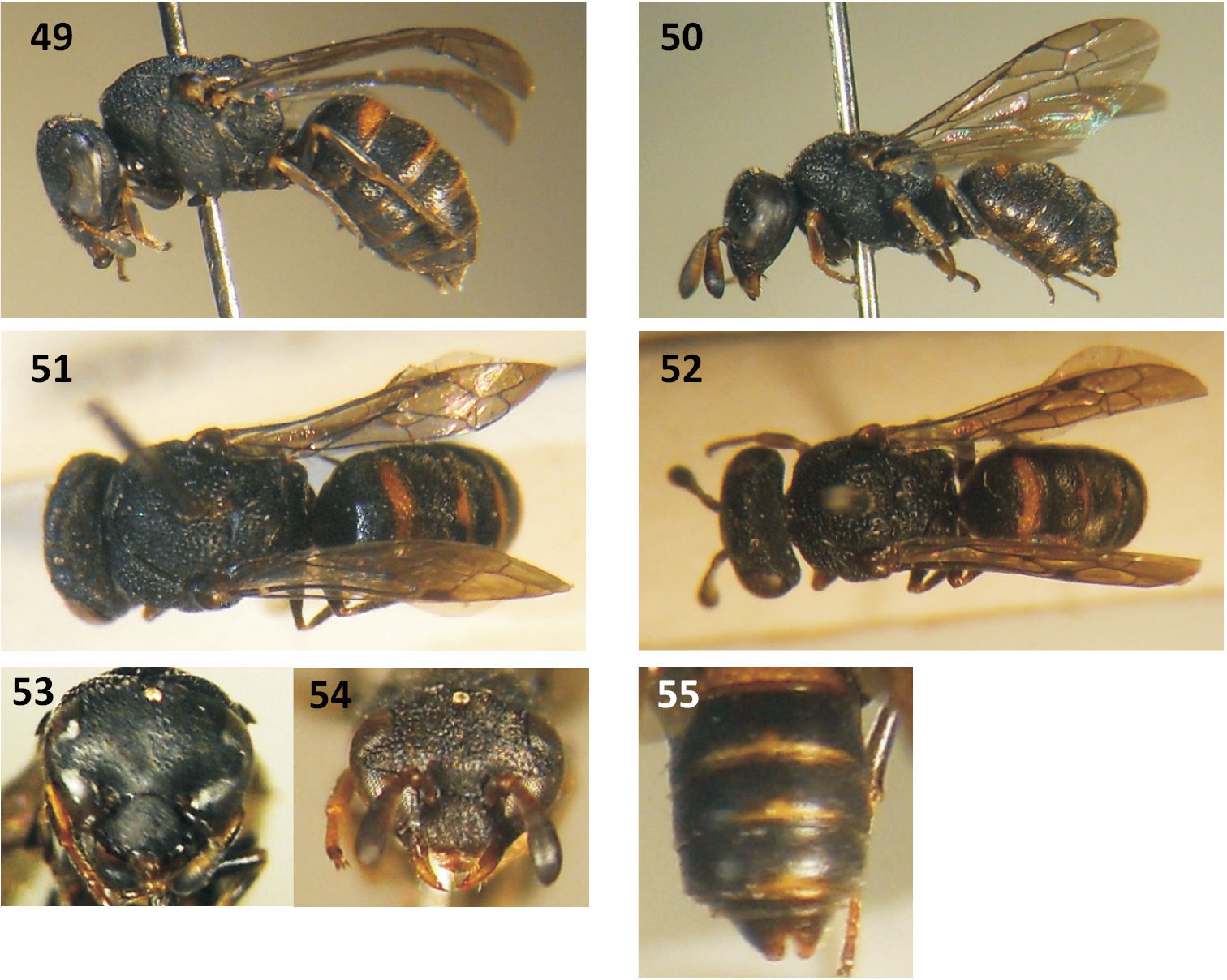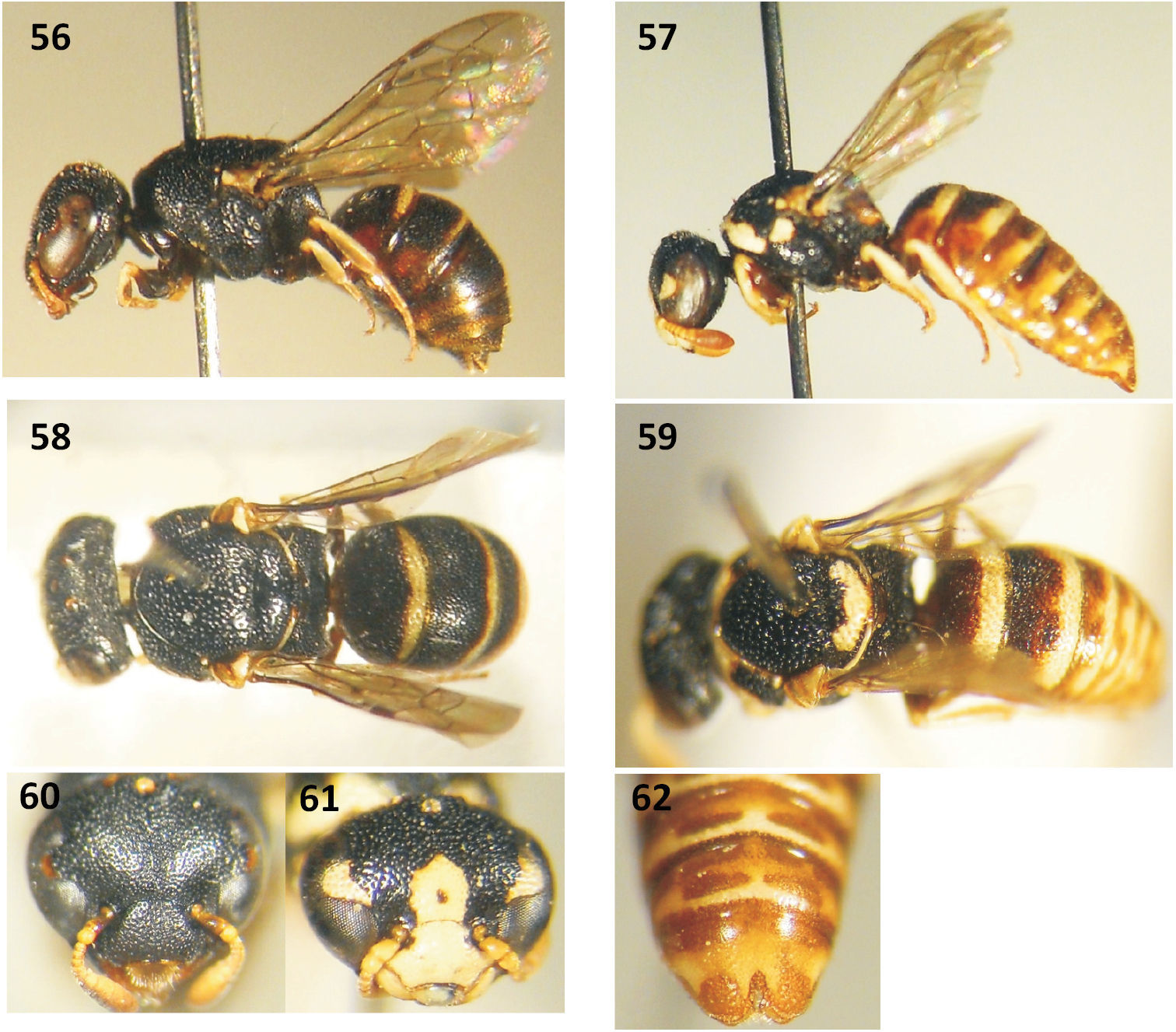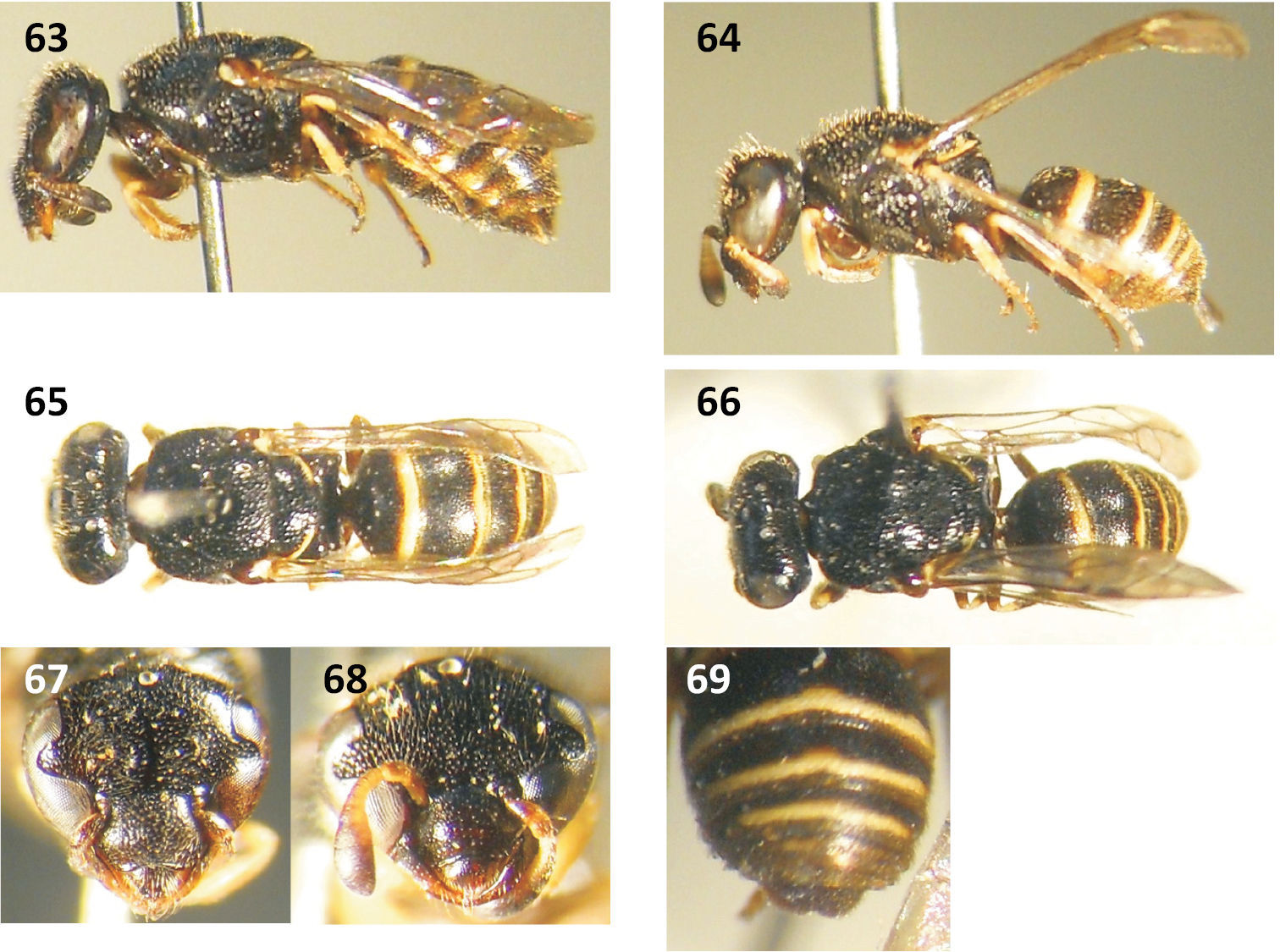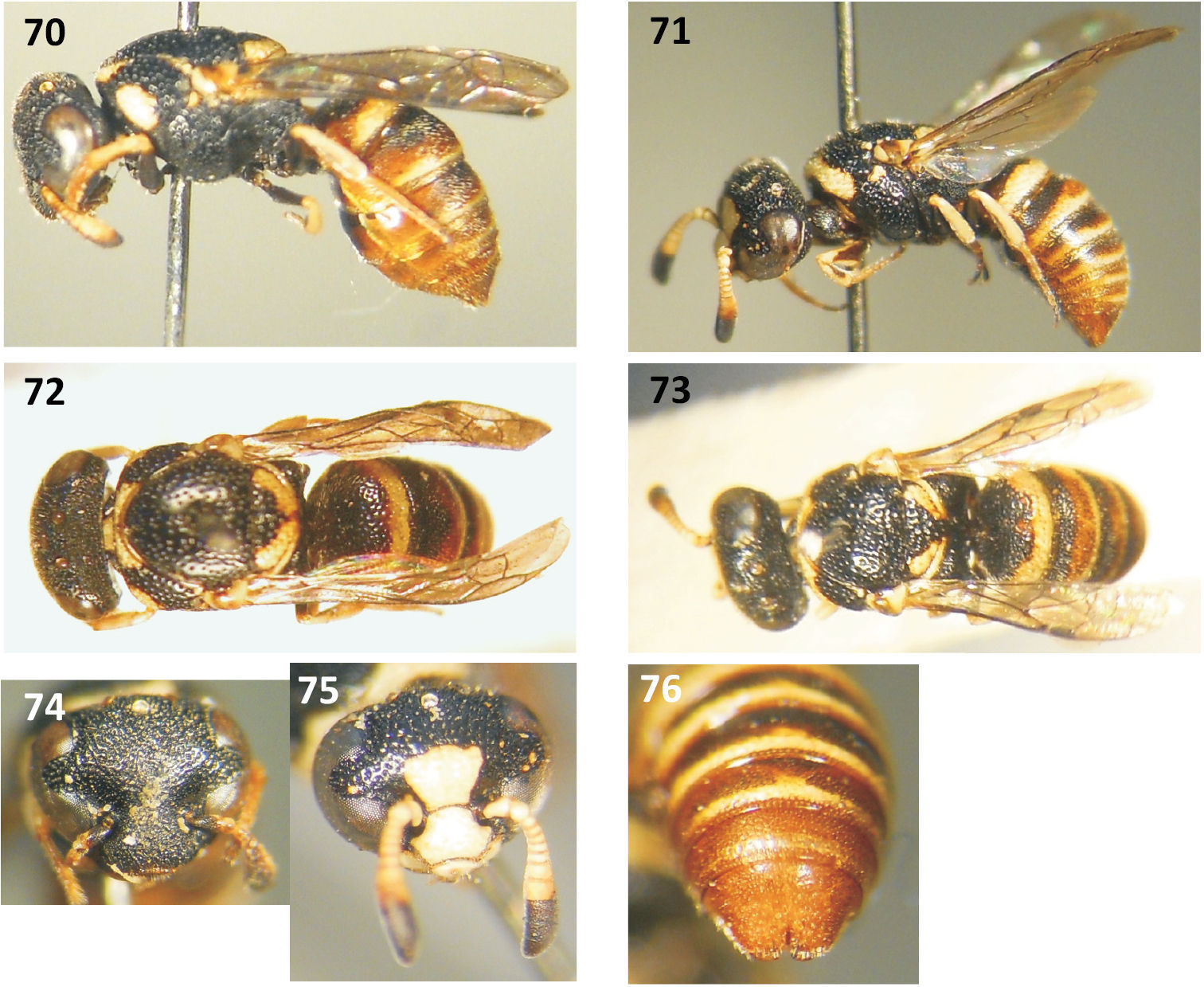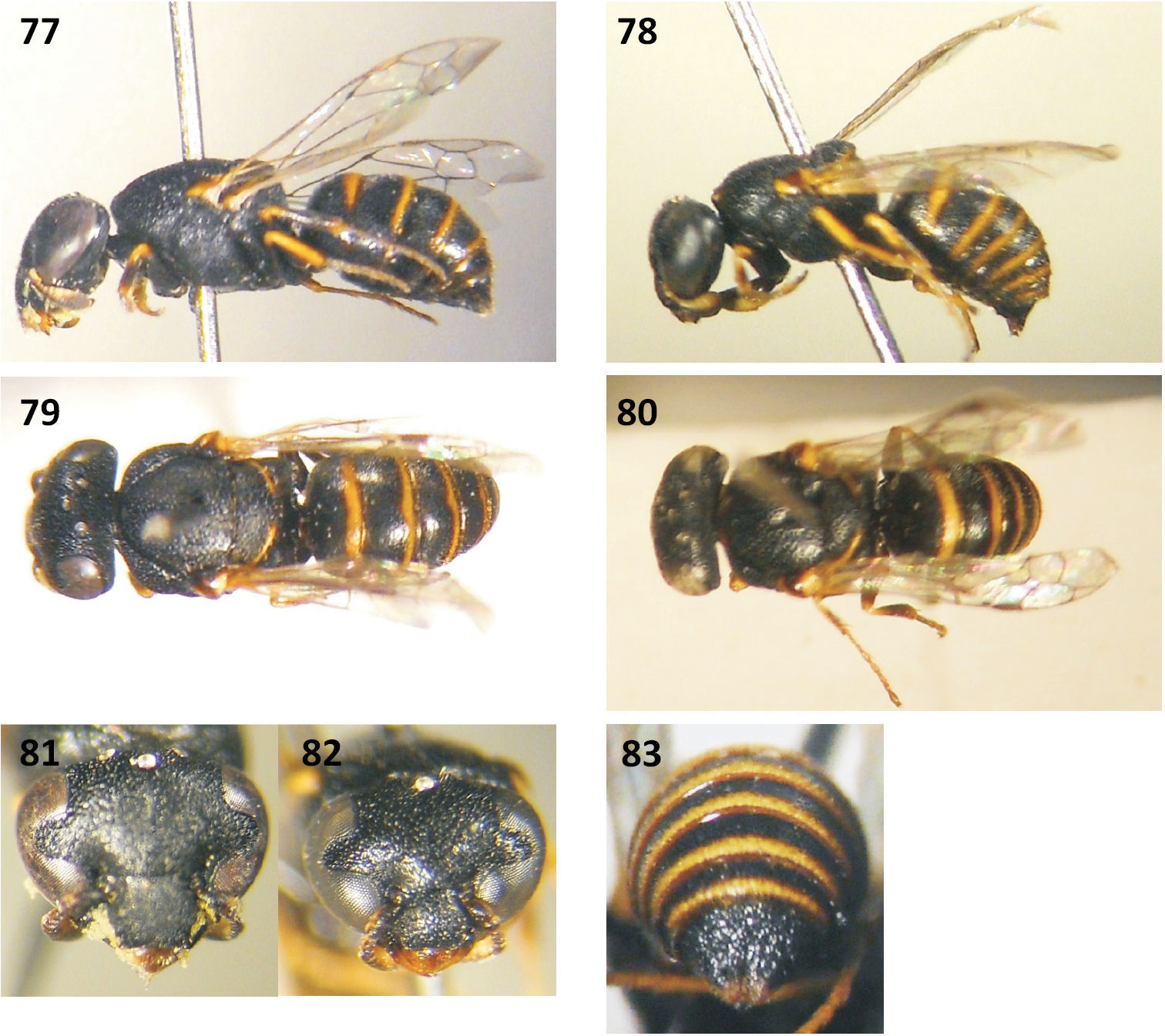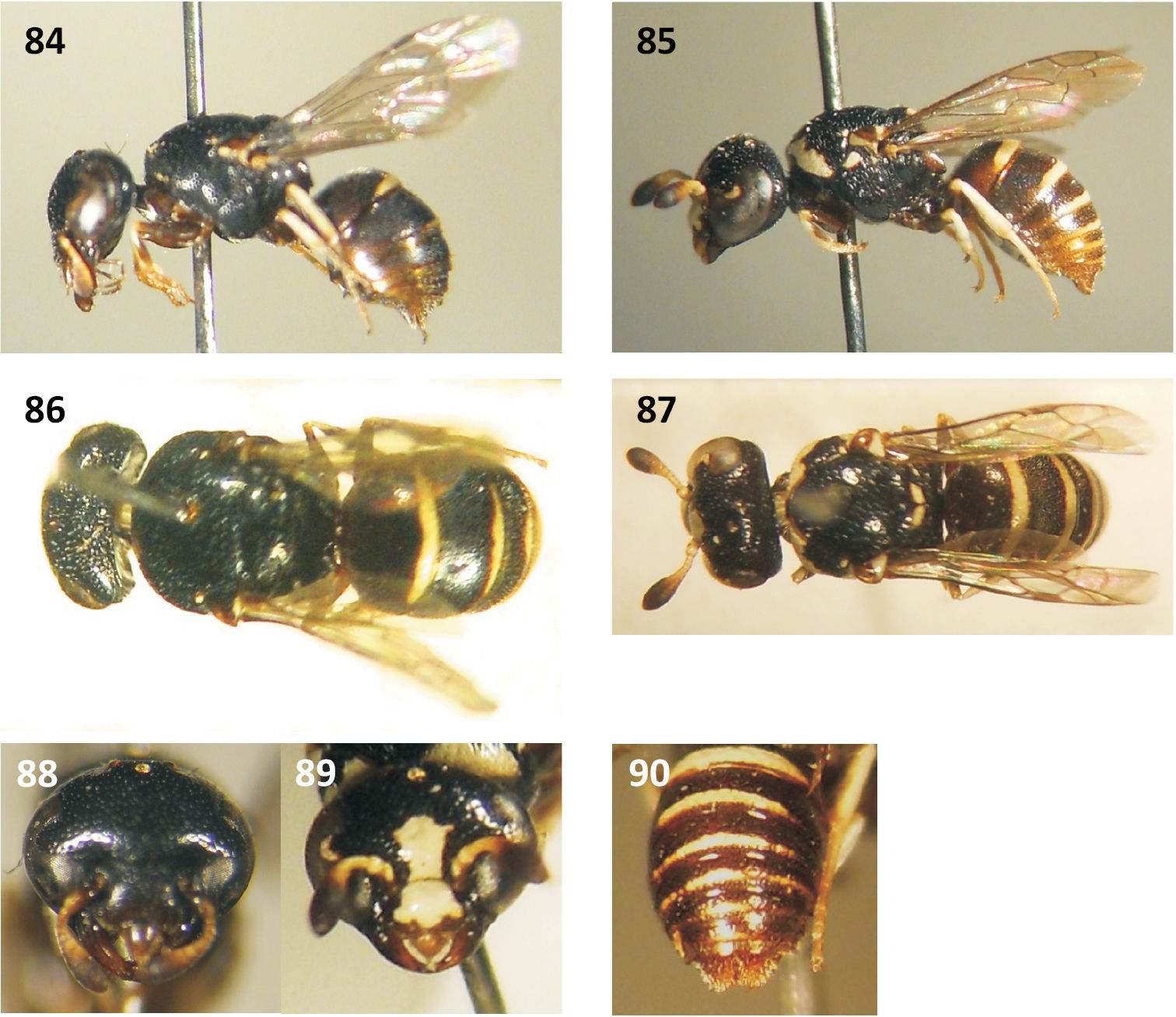(C) 2010 Friedrich W. Gess. This is an open access article distributed under the terms of the Creative Commons Attribution License, which permits unrestricted use, distribution, and reproduction in any medium, provided the original author and source are credited.
For reference, use of the paginated PDF or printed version of this article is recommended.
In this publication, the fourth of a projected series revising the Afrotropical species of the genus Quartinia Ed. André, 1884 (Hymenoptera: Vespidae: Masarinae), 14 species with complete venation are dealt with.
Ten new species are described: Quartinia arenaria, Quartinia atlantica and Quartinia luteomandibulata from the seaboard of the Western Cape of South Africa, Quartinia namibensis from south-western Namibia and Quartinia carolinae, Quartinia frontalis, Quartinia scutellaris, Quartinia setaria, Quartinia setositerminalis and Quartinia upingtonensis from the Northern Cape of South Africa. The hitherto unknown female of Quartinia namaquensis Gess and the males of Quartinia persephone Richards and Quartinia vagepunctata Richards are described. The identity of the male of Quartinia parcepunctata Richards as described by Richards is confirmed. A key to facilitate the separation of the sympatric and generally similar looking Quartinia frontalis, Quartinia scutellaris, Quartinia setositerminalis and Quartinia vagepunctata is given.
Extensive collection data pertaining to most of the species contribute to the knowledge of their distribution and floral associations.
Southern Africa, taxonomy, floral associations
The background to the present state of knowledge of the taxonomy of the genus Quartinia Ed. André, 1884 has been fully stated in
Desirable as it might be to undertake a complete revision
of the genus, this is at present not practicable. Rather than to get
bogged down in a study which might never be completed and published, it
is intended to publish a series of papers describing new species as
well as reviewing some known species. It is envisioned that a new key to
species will complete the series. To date Parts I, II and III have
been published as
Quartinia species range in length from a little over 2 mm to 7 mm. In comparison with the great majority of species of other genera of Masarinae even the largest Quartinia are relatively small. In view of the considerable range in size shown by species of Quartinia and in order to express relative size, categories based on length have been established for species of the genus. These are minute (1.5–2.5 mm); small (2.5–3.5 mm); medium (3.5–4.5mm); large (4.5–5.5 mm); very large (5.5–6.5 mm) and gigantic (6.5–7.5 mm).
The present paper deals only with species with complete venation (2m-cu present and as thick as other veins).
Acronyms for institutions in which material is housed are: AMG = Albany Museum, Grahamstown, South Africa; AMNH = American Museum of Natural History, New York, United States of America; BMNH = Natural History Museum, London, England; NNIC = Namibian National Insect Collection, Windhoek, Namibia; SAM = South African Museum, Cape Town, South Africa; SANC = South African National Collection of Insects, Pretoria, South Africa.
Taxonomy♂, SOUTH AFRICA: WESTERN CAPE: S of Yzerfontein (33.22S, 18.11E), 15.x.2006 (D. W., G. T. and G. M. Gess) [AMG].
SOUTH AFRICA: WESTERN CAPE: Lutzville – Vredendal (31.36S, 18.23E), 29.ix.2005 (F, W. and S. K. Gess), 6 ♀♀, 1 ♂ (visiting yellow flowers of Conicosia sp., Aizoaceae: Mesembryanthema); Donkinsbaai, 10 km S of Doornbaai (31.54S, 18.17E), 29.ix.2005) F. W. and S. K. Gess), 3 ♀♀ (visiting pink flowers with white centres of Drosanthemum sp., Aizoaceae: Mesembryanthema); Lamberts Bay (32.05S, 18.19E), 28.ix.2005 (F. W. and S. K. Gess), 11 ♀♀ (visiting yellow flowers of Conicosia sp., Aizoaceae: Mesembryanthema); S of Yzerfontein (33.22S, 18.11E), 15.x.2006 (D. W., G. T. and G. M. Gess), 5♀♀, 7 ♂♂; Melkbosstrand (33.42S, 18.26E), 10.x.2005 (F. W. and S. K. Gess), 1 ♀, 2 ♂♂ (on sand beneath flowering Trachyandra sp., Asphodelaceae) – [all AMG].
Quartinia arenaria 1 ♀, lateral view (× 11) 2 ♂, lateral view (× 13) 3 ♀, dorsal view (× 12) 4 ♂, dorsal view (× 11) 5 ♀, head, front view (× 17) 6 ♂, head, front view (× 20) 7 ♂, tergum VII, dorsal view (× 18).
Medium to large (4.2–5.2 mm), gracile (ratio of width to length = 0.27: 1). Fore wing with Cu1a and 2m-cu complete and as thick as other veins. Tegula with posterior inner corner inwardly produced. Both sexes black marked with yellowish-white. Head and mesosoma microsculptured (shagreened). Punctures on clypeus and lower half of frons barely discernable; those on upper half of frons and vertex fine, close, increasingly discernable. Punctures on mesosoma larger and more obvious than on head, subconfluent throughout; those on pronotum coarser than those on mesoscutum and scutellum. Male with labrum, clypeus, transverse mark at bottom of frons, and most of scape yellowish-white. Legs unmodified; sterna atuberculate.
Female (Figs 1, 3, 5): Black. The following are yellowish-white: band (in some specimens reduced and medially interrupted; in others totally effaced) on anterior margin of pronotum and spot (in some specimens totally effaced) on postero-dorsal angle of same; mark (varying from small to totally effaced in majority of specimens) on humeral angle; tegula (except ferruginous median area); scutellar lamella (except postero-medially); posterior bands (not reaching sides and progressively shorter and narrower) on terga I – III, IV or V (most commonly I – IV). Light reddish-yellow are: underside of all flagellomeres (except in some specimens distal flagellomeres of club); apex of femur of all legs, most of tibia (except diffuse ferruginous postero-ventral markings) of fore and middle legs; base of hind tibia; proximal four tarsomeres of fore leg. Various shades of ferruginous are: mandible distally; upper surface of pedicel and proximal flagellomeres; markings on tibia of all legs; ultimate tarsomere of fore leg and all tarsomeres of middle and hind legs. Wings lightly browned; veins brown.
Length: 4.6–5.2 mm (average of 4: 4.9 mm); length of fore wing: 2.7–3.0 mm (average of 4: 2.9 mm); hamuli 4–6.
Head in front view 1.17 × as wide as long; POL: OOL = 1: 0.77. Clypeus 1.55 × as wide as long; anterior margin shallowly emarginate; lateral angles rounded.
Clypeus, frons and vertex finely microsculptured (shagreened); punctures on clypeus and lower half of frons barely discernable; those on upper half of frons and vertex fine, close, increasingly discernable. Mesosoma finely microsculptured (shagreened); punctures larger than those on head, those on pronotum coarser than those on mesoscutum and scutellum, subconfluent throughout. Gaster very finely punctured, shiny.
Male (Figs 2, 4, 6, 7): Black. The following are yellowish-white: small spot near base of mandible (in one specimen from Melkbosstrand only); labrum (except in some specimens testaceous distal margin); clypeus; transverse mark (in some specimens dorsally bilobed) at bottom of frons and contiguous with white clypeus; most of scape (except black streak dorsally); underside of pedicel; band on anterior margin (in some specimens medially interrupted) of pronotum and spot on postero-dorsal angle of same; mark (varying from large to almost totally effaced) on humeral angle; small spot at top of mesopleuron (in some specimens only); tegula (except ferruginous median area); scutellar lamella (except postero-medially); posterior bands (not reaching sides and progressively shorter and narrower) on terga I – VI. Light reddish-yellow are: underside of all flagellomeres; apex of femur of all legs; most of tibia (except diffuse ferruginous postero-ventral markings) of all legs (or of fore and middle legs and base only of hind leg); proximal four tarsomeres of fore leg. Various shades of ferruginous are: mandible distally; upper surface of pedicel and flagellomeres; markings on tibia of all legs; ultimate tarsomere of fore leg and all tarsomeres of middle and hind legs; parameres (generally light ferruginous but with margins narrowly dark ferruginous).
Length: 4.2–4.8 mm (average of 4: 4.5 mm); length of fore wing: 2.6–2.9 mm (average of 4: 2.7 mm); hamuli 5.
Head in front view 1.3 × as wide as long; POL: OOL = 1: 0.67. Clypeus 1.6 × as wide as long; anterior margin shallowly emarginate; lateral angles rounded.
Puncturation of head, mesosoma and gaster as in female. TergumVII more coarsely sculptured than other terga, apico-medially with a short, narrowly V-shaped slit; lobes flanking slit apically acutely pointed. Sterna atuberculate. Parameres almost rounded apically but slightly angular on inner side of curve; without a distinct tooth.
Named for the sandy terrain to which the species appears to be restricted.
Known from the seaboard of the Western Cape of South Africa, the collecting sites being in the Strandveld of the West Coast of
Aizoaceae: Mesembryanthema (Conicosia, Drosanthemum).
Unknown.
See under Quartinia atlantica.
♀, SOUTH AFRICA: WESTERN CAPE: Blaauwberg – Melkbosstrand (33.46S, 18.27E), 5.x.2005 (F. W. and S. K. Gess) (on sand beneath flowering Trachyandra sp., Asphodelaceae) [AMG].
SOUTH AFRICA: WESTERN CAPE: Koeberg Nature Reserve (33.38S, 18.24E) (West Coast Strandveld dominated by Euphorbia and Rhus spp.), 13.vi.–11.vii.1997 (S. van Noort) (yellow pan trap), 1 ♀; same data but dates and number of specimens as follow: 8.vii.– 5.ix.1997, 1 ♀; 5.ix.– 3.x.1997, 27♀♀; 3.x.–31.x.1997, 24 ♀♀; 31.x.–28.xi.1997, 4 ♀♀. – [5 AMG, all others SAM].
Quartinia atlantica 8 ♀, lateral view (× 10) 9 ♀, dorsal view (× 9) 10 ♀, head, front view (× 15).
Large (5.25 mm), robust (ratio of width to length = 0.34: 1). Fore wing with Cu1a and 2m-cu complete and as thick as other veins. Tegula with posterior inner corner inwardly produced. Female (male unknown) black marked with yellowish-white. Head and mesosoma microsculptured (shagreened). Punctures on clypeus and lower half of frons barely discernable; those on upper half of frons and vertex fine, close, increasing discernable. Punctures on mesosoma larger and more obvious than on head; those on pronotum coarse and subconfluent; those on mesoscutum and scutellum finer and discrete.
Female (Figs 8–10): [Based largely on the holotype; the paratypes, having been in alcohol for thirteen years, are somewhat bleached.] Black. The following are yellowish-white: band (in some specimens very narrowly interrupted medially; in one specimen totally effaced) on anterior margin of pronotum and minute spot on postero-dorsal angle of same; streak of varying size (in some specimens effaced) on humeral angle; tegula (except ferruginous median area); scutellar lamella (except postero-medially); posterior bands (not reaching sides and progressively shorter and narrower) on terga I – IV. Light reddish-yellow are: underside of flagellomeres of club; extreme apex of femur and extreme base of tibia of all legs. Various shades of ferruginous are: mandible distally; tarsomeres (particularly underside) of all legs. Wings slightly browned; veins dark brown.
Length of holotype 5.25 mm. [Length of paratypes impossible to establish due to alcohol induced extension and curvature of gaster but likely to have been similar as measurement of mesosoma is same as that of holotype]. Length of fore wing: 3.6 mm; hamuli 5.
Head in front view 1.27 × as wide as long; POL: OOL = 1: 0.7. Clypeus 1.4 × as wide as long; anterior margin shallowly emarginate; antero-lateral angles rounded.
Clypeus, frons and vertex finely microsculptured (shagreened); punctures on clypeus and lower half of frons barely discernable; those on upper half of frons and vertex fine, close, increasing discernable. Mesosoma finely microsculptured (shagreened); punctures larger than those on head, those on pronotum coarse and subconfluent, those on mesoscutum and scutellum finer and discrete. Gaster very finely punctured, shiny.
Male: Unknown.
Named for the Atlantic seaboard where the species occurs.
Known from the seaboard of Western Cape of South Africa, the collecting sites being in the Strandveld of the West Coast of
Unknown.
Unknown.
Quartinia atlantica differs most obviously from Quartinia arenaria in that it is a robust species whereas the latter is a gracile species. This can readily be seen not only by comparing specimens of the two species by eye but by measurement. Two females of equal length (5.25 mm), one of each species (for Quartinia atlantica the unstretched holotype), were measured for head and thorax width (head width = thorax width) which for Quartinia atlantica was 1.78 mm and for Quartinia arenaria a mere 1.42 mm. Expressed as the ratio of width to body length, the values are 0.34: 1 for Quartinia atlantica and 0.27: 1 for Quartinia arenaria.
Yellow pan trapping by S. van Noort at Koeberg Nature Reserve during 1997 yielded not only Quartinia atlantica Gess but also Quartinia bonaespei Gess, the former during the period 13 June to 28 November, the latter during the period 11 July to 28 November. No males of either species were obtained.
♂, SOUTH AFRICA: NORTHERN CAPE: Namaqualand, Leliefontein (30.23S, 18.16E), 19.ix.2002 (C. Mayer) (yellow trap) [AMG].
SOUTH AFRICA: NORTHERN CAPE: Namaqualand,
Leliefontein (30.23S, 18.16E), 5.ix.2002, ♀ (white trap); same locality, 19.ix.2002, 1 ♀, 2 ♂♂ (1 ♀, 1 ♂ yellow trap; 1 ♂ white trap); same locality, 21.ix.2002, 2 ♀♀ (1 ♀ yellow trap; 1 ♀ white trap); same locality, 7.x.2002, 1 ♂ (white trap); same locality, 14.x.2002, 1 ♀ (white trap); Namaqualand, Remhoogte (30.23S, 18.16E), 12.ix.2002, 1 ♂ (white trap); same locality, 19.ix.2002, 1 ♂ (yellow trap); same locality, 21.ix.2002, 1 ♀ (yellow trap); same locality, 27.ix.2002, 1 ♂ (white trap); Namaqualand, Remhoogte (30.24S, 18.17E), 19.ix.2002, 3 ♀♀ (yellow trap); same locality, 21.ix.2002, 1 ♀ (yellow trap) – all C. Mayer [all AMG].
Quartinia carolinae 11 ♀, lateral view (× 10) 12 ♂, lateral view (× 10) 13 ♀, dorsal view (× 10) 14 ♂, dorsal view (× 10) 15 ♀, head, front view (× 17) 16 ♂, head, front view (×18) 17 ♂, tergum VII, dorsal view (× 16) 18 ♂, end of gaster showing tubercle on sternum VII, lateral view (× 22).
Large (4.5–5.3 mm). Fore wing with Cu1a and 2m-cu complete and as thick as other veins. Tegula with posterior inner corner inwardly produced. Both sexes black marked with various shades of ferruginous. Male with sternum VII raised postero-medially to form a postero-ventrally directed tubercle.
Female (Figs 11, 13, 15): Black. The following are yellowish ferruginous: underside of pedicel and flagellomeres (most noticeably underside of antennal club); tegula anteriorly and posteriorly; scutellar lamella laterally; apex of all femora; dorsal and anterior aspects of fore tibia; anterior aspect of middle and hind tibiae; proximal four tarsomeres of fore leg. Ferruginous are: mandible (except base); labrum; upperside of antenna; narrow and short band medially on pronotal dorsum; tegula medially; posterior bands (reaching sides and progressively narrower) on terga I – V; narrow posterior bands on sterna II – V (in some specimens); tibia and tarsomeres (other than for parts listed above) of all legs. Wings lightly browned; veins brown.
Length: 5.0–5.3 mm (average of 3: 5.1 mm); length of fore wing 3.0–3.2 mm (average of 3: 3.1 mm); hamuli 5.
Head in front view 1.3 × as wide as long; finely microreticulate (shagreened), moderately shiny, with shallow, indistinct punctures (more discernable on frons and vertex than on clypeus); POL: OOL = 1: 0.82. Clypeus 1.5 × as wide as long; anterior margin evenly emarginate; antero-lateral angles rounded.
Mesosoma microreticulate (shagreened), moderately shiny, with close punctures much larger than those on head.
Gaster very finely microreticulate, moderately shiny, with a few punctures (smaller than those on mesosoma) postero-medially on terga I and II.
Setae short and fine throughout.
Male (Figs 12, 14, 16–18): Black. Nature and distribution of markings very similar to those of female. Labrum of some specimens (including holotype) yellowish-ferruginous rather than ferruginous and therefore contrasting markedly with black clypeus. Tergum VI with a narrow ferruginous posterior band. Surface sculpture and setation as in female.
Length: 4.5–4.8 mm (average of 3: 4.6 mm); length of fore wing 2.8–3.1 mm (average of 3: 2.95 mm); hamuli 5–6.
Head in front view 1.3 × as wide as long; POL: OOL = 1: 0.82. Clypeus 1.5 × as wide as long.
Tergum VII with disc in proximal third slightly depressed, apico-medially with a narrow, subparallel-sided slit, and with lobes flanking slit rounded. Sternum VII raised postero-medially to form a postero-ventrally directed tubercle.
Named for Caroline Mayer of BIOTA-Southern Africa, Hamburg University, who collected the material during her studies in Namaqualand.
Known only from two contiguous localities situated in the Macchia (Fynbos) of the Kamiesberg.
Unknown.
Unknown.
urn:lsid:zoobank.org:act:E6384D4B-8E6D-4DE5-851C-EF604D2D2C4C
Figs 19–24♂, SOUTH AFRICA: NORTHERN CAPE: Namaqualand, Springbok, Hester Malan Nature Reserve [Goegap], 10–11.x.1989 (F. W. and S. K. Gess) (visiting fls of Wahlenbergia pilosa Buek., Campanulaceae) [AMG].
SOUTH AFRICA: NORTHERN CAPE: Namaqualand, Springbok, Hester Malan Nature Reserve [Goegap], 10–12.x.1988, 1 ♂; same locality, 10–11.x.1989, 5 ♀♀, 1 ♂ (visiting fls of Wahlenbergia pilosa Buek., Campanulaceae); Goegap (windmill site) (29.37S, 17.59E), 5.x.1994, 1 ♀, 1 ♂ (on yellow fls of Leysera tenella A. DC., Asteraceae); same locality, 7.x.1994, 1 ♀ (on/in fls of Wahlenbergia namaquana Sond.); Goegap (Kraaiwater site) (29.38S, 18.00E), 30.ix.1997, 2 ♀♀ (1 ♀ visiting pale pink fls of Psilocaulon acutisepalum (Berger) N. E. Br., Aizoaceae: Mesembryanthema; 1 ♀ visiting dark pink fls of Galenia sarcophylla Fenzl, Aizoaceae: non-Mesembryanthema); Namaqualand, Voëlklip (29.45S, 17.22E), 2.x.1994, 24 ♀♀ (13 ♀♀ on light violet fls of Wahlenbergia annularis A. DC.; 9 ♀♀ on small pinkish-violet fls of Wahlenbergia namaquana; 2 ♀♀ on dry sandy ground); same locality, 7.x.1994, 25 ♀♀ (7 ♀♀ on light violet fls of Wahlenbergia annularis; 17 ♀♀ on small pinkish-violet fls of Wahlenbergia namaquana; 1 ♀ on violet fls of Wahlenbergia pilosa); Namaqualand, 25 km N [of] Kamieskroon (30.01S, 17.33E), 17.x.2000, 3 ♀♀ (visiting yellow fls of Leysera tenella); Namaqualand, Taaiboskraal/Anagas (30.07S, 18.01E), 3.x.1995 (F. W., S. K. and R. W. Gess), 3 ♀♀ (1 ♀ in violet flowers of Wahlenbergia sp.);Namaqualand, Sors Sors/Taaiboskraal (30.08S, 18.01E), 3.x.1995 (F. W., S. K. and R. W. Gess), 1 ♀, 1 ♂ (in violet flowers of Wahlenbergia sp.) – (all F. W. and S. K.Gess, unless otherwise stated) [all AMG]; [Namaqualand], Farm Dassiefontein near Kamieskroon (30.09S, 17.59E), 1.x.1990 (C. Eardley), 1 ♀ [SANC]; [Namaqualand], Farm Arkoep, 6 km N [of] Kamieskroon (30.19S, 17.56E), 1–2.x.1990 (C. Eardley), 15 ♀♀, 2 ♂♂ [SANC].
Quartinia frontalis 19 ♀, lateral view (× 10) 20 ♂, lateral view (× 12) 21 ♀, dorsal view (× 10) 22 ♂, dorsal view (× 12) 23 ♀, head, front view (× 15) 24 ♂, head, front view (× 17).
Medium to large (4.4–5.5 mm). Fore wing with Cu1a and 2m-cu complete and as thick as other veins. Both sexes with thorax and gaster subshiny with coarse punctures; scutellum only gently convex medially. Female with scutellum black and lamella pale. Male with mandible white and tip ferruginous; labrum and clypeus wholly white; antennal club black dorsally, white ventrally; frons with white marking expanded laterally into (but not filling) ocular sinus; scutellum with a pair of pale streaks laterally and pale lamella; sternum VII subglabrous and apically with fringe of fine setae.
Female (Figs 19, 21, 23): Black. The following are yellowish-white: underside of antenna; pair of streaks (usually joined medially) on pronotal dorsum and minute spot at postero-dorsal angle of same; humeral spot (in minority of specimens); tegula anteriorly and posteriorly; scutellar lamella laterally; posterior bands (not reaching sides and progressively reduced) on terga I – V; apex of femur, most of tibia, all but last tarsomere of all legs. The following are ferruginous: mandible (except base); upper side of antenna; tegula medially; terga I – V narrowly laterally and posteriorly; sterna narrowly posteriorly; last tarsomere. Wings lightly browned; veins brown.
Length 5.4–5.5 mm (average of 3: 5.4 mm); length of fore wing 3.3–3.4 mm (average of 3: 3.4 mm); hamuli 4–5.
Head in front view 1.3 × as wide as long; with moderately coarse sub-confluent punctures and microreticulate interstices. POL: OOL = 1: 0.85. Clypeus 1.5 × as wide as long (to bottom of emargination); convex, markedly raised laterally and distally, falling steeply to anterior margin; anterior margin very shallowly and widely emarginate; antero-lateral angles rounded.
Mesosoma subshiny with coarse punctures separated by less than their diameter (on the pronotum) or by their diameter or more (on the centre of the mesoscutum and on the scutellum); interstices very finely microreticulate (shagreened). Tegula with inner posterior corner markedly inwardly produced. Fore wing with Cu1a and 2m-cu complete and as thick as other veins. Scutellum medially evenly and gently convex.
Gaster with first and second terga with coarse sub-confluent punctures and shagreened interstices; terga III – VI with puncturation progressively less coarse and closer.
Male (Figs 20, 22, 24): Black. The following are yellowish white: mandible (except tip); labrum; clypeus; large marking on frons with its base immediately above clypeus and dorsally expanded laterally into (but not filling) ocular sinus; scape, pedicel and proximal flagellomeres; broad band across anterior margin of pronotum (carried down to humeral angle) and small spot on postero-dorsal angle of same; a minute to small streakat top of mesopleuron; tegula anteriorly and posteriorly; a pair of lateral spots on scutellum; scutellar lamella laterally; posterior bands (not reaching sides and progressively reduced) on terga I – VI; diffuse area on tergum VII; apex of femur, most of tibia, proximal four tarsomeres of all legs. The following are ferruginous: mandibular tip; antennal club (dark above, light below); lateral margins of terga and posterior bands laterally; irregular narrow band between yellowish-white posterior band and basal black area on terga I – VI; irregular non yellowish-white areas on tergum VII; all sterna; last tarsomere of all legs. Wings very lightly browned; veins brown.
Length 4.4–4.6 mm (average of 3: 4.5 mm); length of fore wing 2.80–2.84 mm (average of 3: 2.8 mm); hamuli 4–5.
Head in front view 1.5 × as wide as long; POL: OOL = 1: 0.9. Clypeus 1.67 × as wide as long (to bottom of emargination), convex, markedly raised laterally and distally, falling steeply to anterior margin; anterior margin very shallowly and widely emarginate; antero-lateral angles rounded. Puncturation of head, mesosoma and gaster similar to that of female.
Gaster with tergum VII with a short median V-shaped slit; lobes flanking slit rounded. Sterna atuberculate; sternum VII subglabrous with only a few scattered, fine setae and apically with fringe of closer fine setae.
The name Quartinia frontalis serves to draw attention to the frons which in the male has a characteristic white marking expanded laterally into (but not filling) the ocular sinus.
Known from the north-western Northern Cape
(Namaqualand; winter rainfall region) of South Africa, the collecting
localities being sited in the Namaqualand BrokenVeld and the Mountain
Renosterbosveld of
Principally Campanulaceae (Wahlenbergia); to a lesser extent Asteraceae (Leysera) and Aizoaceae (Galenia and Psilocaulon).
Unknown.
Sympatric with the generally similar looking Quartinia scutellaris, Quartinia setositerminalis and Quartinia vagepunctata.
urn:lsid:zoobank.org:act:B45854D1-0427-4FD2-80A2-F9151C385992
Figs 25–27♀, SOUTH AFRICA: WESTERN CAPE: Lamberts Bay (32.05S, 18.19E), 28.ix.2005 (F. W. and S. K. Gess) (visiting yellow flowers of Conocosia sp., Aizoaceae: Mesembryanthema) [AMG].
SOUTH AFRICA: NORTHERN CAPE: Koingnaas Mines (30.10S, 17.14E), 12–17.xi.2007 (C. Lyons), ♀ (from pan trap) [AMG]; SOUTH AFRICA: WESTERN CAPE: Lamberts Bay (32.05S, 18.19E), 28.ix.2005 (F. W. and S. K. Gess), ♀ (visiting yellow flowers of Conocosia sp., Aizoaceae: Mesembryanthema) [AMG].
Quartinia luteomandibulata 25 ♀, lateral view (× 10) 26 ♀, dorsal view (× 11) 27 ♀, head, front view (× 15).
Large (5.2–5.6 mm). Fore wing with Cu1a and 2m-cu complete and as thick as other veins. Tegula with posterior inner corner inwardly produced. Female (male unknown) with mandible at least in part pale yellow, contrasting strikingly with totally black clypeus.
Female (Figs 25–27): Black. The following are pale yellow: basal half of mandible (to variable extent; tending proximally to change to light ferruginous); underside of scape, pedicel and proximal flagellomeres; pair of large quadrangular markings (in paratype from Koingnaas partly fused) on lower half of frons immediately above clypeo-frontal suture; most of ocular sinus; streak of variable length on temple behind top of eye; pair of wedge-shaped markings (meeting or very narrowly separated medially) on anterior margin of pronotum and extreme postero-dorsal angle of same; large mark on humeral angle; mark of variable extent (large or broken up into a number of small spots or totally effaced) on mesopleuron; tegula (except for ferruginous median area); spot basally on each side of scutellum (effaced in paratype from Lamberts Bay); scutellar lamella (interrupted posteriorly); marking on propodeal angle (reduced in paratype from Lamberts Bay to small spot on dorsum of propodeum); posterior bands reaching or not reaching sides on terga I – V; band on tergum I widest; those on terga I – V progressively narrower but medially and laterally slightly anteriorly produced; apex of femur, tibia (except dark area posteriorly at mid length) of all legs. Light ferruginous are: apical half or more of mandible; underside of antennal club; tarsomeres of all legs. Dark ferruginous are: apex of mandible; labrum; upper side of antenna; median area of tegula; claws. Wings very lightly browned; veins brown.
Length 5.2–5.6 mm (average of 3: 5.5 mm); length of fore wing 3.3 mm (average of 3); hamuli 4.
Head in front view 1.3 × as wide as long; POL: OOL = 1: 0.6. Clypeus 1.43 × as wide as long; anterior margin widely V-shaped; antero-lateral corners obtusely rounded.
Clypeus, frons and vertex microreticulate (shagreened) with small, close, not very discernable punctures; mesosoma microreticulate (shagreened) with obvious punctures, larger than those on vertex; punctures on mesonotum with interstices equal to or exceeding puncture width, those on scutellum generally closer; gaster moderately shiny, very finely microreticulate (shagreened), with very small punctures.
Male: Unknown.
The name Quartinia luteomandibulata refers to the female’s predominantly yellow mandibles which contrast strikingly with the totally black clypeus and in so doing present a most unusual appearance.
Known only from two localities on the west coast
of the Northern and Western Cape, both being in the Strandveld of the
West Coast of
Aizoaceae: Mesembryanthema (Conocosia sp.).
Unknown.
Figs 28–34
This species was described from three males from Leliefontein, collected by Caroline Mayer and one male from W of Wallekraal, collected by F. W. and S. K. Gess. The female was stated to be unknown, “none of the specimens of several species from the relevant localities being assignable with any degree of confidence to this species”.
Recent collecting at Rooikloof Farm near Sutherland by F. W. and S. K. Gess and others produced a single male of Quartinia namaquensis and 58 females, believed to be conspecific, the male and the great majority of the females visiting the flowers of Wahlenbergia near polyclada A.DC (Campanulaceae). The scarcity of males was most likely due to the fact that collecting took place towards the end the species’ flight period at that particular locality.
In the light of the above association, the undetermined material collected by Caroline Mayer was re-examined and it was found that four females, two from Leliefontein (the type locality of the male) and two from nearby Remhoogte, were clearly conspecific with the females from Rooikloof Farm, and that these should therefore likewise be assigned to Quartinia namaquensis.
Quartinia namaquensis 28 ♀, lateral view (× 10) 29 ♂, lateral view (× 9) 30 ♀, dorsal view (× 9) 31 ♂, dorsal view (× 9) 32 ♀, head, front view (× 14) 33 ♂, head, front view (× 10) 34 ♂, tergum VII, dorsal view (× 13).
Female (hitherto undescribed) (Figs 28, 30, 32): Virtually indistinguishable from the female of Quartinia conchicola
Gess, the differences being subtle. Most notable is that the vertex
behind the posterior ocelli is rounded, not depressed and somewhat
concave. The occipital carina therefore appears less pronounced.
Satisfactory identification of the females of both species is, however,
dependant upon their association with the relative males which, in
their secondary sexual characters, are strikingly distinct (see
Male (previously adequately described) (Figs 29, 31, 33, 34).
SOUTH AFRICA: NORTHERN CAPE: Leliefontein (30.23S, 18.16E), 11.ix.2003 (C. Mayer), 1 ♀ (yellow trap); same locality, 23.ix.2003 (C. Mayer), 1 ♀ (white trap); Remhoogte (30.23S, 18.16E), 11.ix.2003 (C. Mayer), 2 ♀♀ (1 ♀ yellow trap; 1 ♀ white trap); Sutherland district, Rooikloof Farm (32.26S, 20.39E), 30.ix.2009 (F.W. and S. K. Gess), 12 ♀♀ (5 ♀♀ visiting pale violet flowers of Wahlenbergia near polyclada A.DC., Campanulaceae; 4 ♀♀ visiting yellow flowers of Leysera tenella DC., Asteraceae; 3 ♀♀ visiting pale violet flowers of Selago sp., Scrophulariaceae); same locality, 1.x.2009 (F. W. and S. K. Gess), 10 ♀♀, 1 ♂ (6 ♀♀, 1 ♂ visiting pale violet flowers of Wahlenbergia near polyclada; 3 ♀♀ on ground between plants of Wahlenbergia near polyclada); same locality, 5.x.2009 (F. W. and S. K. Gess), 16 ♀♀ (10 ♀♀ visiting pale violet flowers of Wahlenbergia near polyclada; 3 ♀♀ visiting pale violet flowers of Selago sp., ); same locality, 8.x.2009 (F. W. and S. K. Gess), 4 ♀♀ (visiting pale violet flowers of Wahlenbergia near polyclada); same locality, 9.x.2009 (F. W. and S. K. Gess), 11 ♀♀ (9 ♀♀ from yellow pan traps associated with Wahlenbergia near polyclada; 1 ♀ from yellow pan traps associated with pale violet flowered Selago sp.; 1 ♀ from yellow pan traps associated with Leysera tenella); same locality, 10.x.2009 (D. W. Gess), 4 ♀♀ (2 ♀♀ visiting pale violet flowers of Wahlenbergia near polyclada; 2 ♀♀ visiting yellow flowers of Chrysocoma sp., Asteraceae); same locality and date (F. W. and S. K. Gess), 1 ♀ associated with Wahlenbergia near polyclada) – [all AMG].
Known from the Northern Cape, the collecting
localities being sited in the Succulent Karoo, the Mountain
Renosterbosveld and at the interface of the Mountain Renosterbosveld and
the Western Mountain Karoo of
Asteraceae (Chrysocoma, Leysera), Campanulaceae (Wahlenbergia) and Scrophulariaceae (Selago). The floral associations were previously unknown (see Gess, 2007: 221).
As was recorded previously (
urn:lsid:zoobank.org:act:48F4044D-C087-4B62-88C7-D7E4E9C76ED9
Figs 35–41♀, NAMIBIA: Sperrgebiet, Klinghardtberge, Tsabiam’s Camp (27.10S, 15.42E), 4.ix.2002 (F. W. and S. K. Gess) [AMG].
NAMIBIA: Sperrgebiet, Klinghardtberge, Nomitsas (27.27S, 15.52E), 31.viii.2002 (F. W. and S. K. Gess), ♀ (visiting yellow flowers of Grielum sinuatum Licht. ex Burch., Neuradaceae) [AMG]; NAMIBIA: Diamond Area 1: Roter Kamm (27.46S, 16.18E), 25–30.vi.1989 (C. S. Roberts), 2 ♂♂ [♂ NNIC; ♂ AMG].
Quartinia namibensis 35 ♀, lateral view (× 10) 36 ♂, lateral view (× 12) 37 ♀, dorsal view (× 10) 38 ♂, dorsal view (× 12) 39 ♀, head, front view (× 14) 40 ♂, head, front view (× 16) 41 ♂, tergum VII, dorsal view (× 12).
Large (4.8–5.4 mm). Fore wing with Cu1a and 2m-cu complete and as thick as the other veins. Tegula whitish-yellow (other than for testaceous median area), with posterior inner corner inwardly produced and acute. Mesosoma and gaster black, richly marked with whitish-yellow. Metanotum of both sexes whitish-yellow. Male with striking and unique, long, pale, apically curved setae on ventral surface of flagellomeres 1–7, on labrum and on distal third of clypeus.
Female (Figs 35, 37, 39): Black. The following are various shades of whitish-yellow: underside of antenna; medially interrupted band on anterior margin of pronotum, carried down to and expanded in humeral area, and narrowly extended along hind margin to postero-dorsal angle; tegula (other than for testaceous median area); tri-lobed curved band on disk of scutellum (leaving a bi-lobed black basal area); entire scutellar lamella; metanotum; ill-defined small area dorsally on propodeum (in paratype only); posterior bands attaining sides and somewhat anteriorly widened medially and laterally on terga I – V. Reddish yellow are: narrow subapical posterior bands on sterna II – V; median part of mandible; apex of femur, tibia (except dark brown streak on fore tibia) and tarsus of all legs. Upper surface of antenna dark reddish-brown; wings sub-hyaline; stigma and veins light brown.
Length 5.4 mm; length of fore wing 3.6 mm; hamuli 4.
Head in front view 1.35 × as wide as long. POL: OOL = 1: 0.55. Clypeus, frons and vertex microreticulate (shagreened) with dense, small, shallow punctures (barely discernable on clypeus and lower half of frons, obvious on upper half of frons and on vertex).
Thorax semi-matt, distinctly microreticulate (shagreened) and punctured; punctures larger and more clearly defined than on head; interstices varying from less than puncture width to more than double puncture width. Tegula with posterior inner corner inwardly produced and acute. Fore wing with Cu1a and 2m-cu complete and as thick as the other veins.
Gaster moderately shiny, with small, indistinct punctures.
Male (Figs 36, 38, 40, 41): Black. The following are various shades of whitish-yellow: antenna (except narrow ferruginous mark dorsally on scape, pedicel and proximal flagellomeres); mandible; labrum; clypeus; paraocular area (streak carried narrowly upwards from mandibular insertion into lower half of ocular sinus where slightly widened); large, median, dorsally bi-lobed marking on frons (extending from clypeo-frontal suture to level of top of ocular sinus); band on anterior margin of pronotum, carried down to and expanded in humeral area, and narrowly extended along hind margin to postero-dorsal angle; tegula (other than for testaceous median area); transverse, postero-median spot on scutellum; entire scutellar lamella; metanotum; posterior bands attaining sides and slightly anteriorly widened medially and laterally on terga I – VI. Reddish-yellow are: apex of femur, tibia (except dark brown streak on fore tibia) and tarsus of all legs. Wings sub-hyaline; stigma and veins light brown.
Length circa 4.8 mm; length of fore wing 3.1 mm; hamuli 4.
Head in front view 1.4 × as wide as long; POL: OOL = 1: 0.6.
Surface sculpture of head, thorax and gaster as in female. Tegula as in female. Flagellomeres 1–7 ventrally, labrum, clypeus on distal third with long, pale, apically curved setae; length of setae on antennae approximating or exceeding width of proximal flagellomeres, that of setae on clypeus longer. Tergum VII somewhat depressed, apico-medially with a V-shaped slit; lobes flanking slit rounded. Sterna atuberculate. Parameres rounded apically, without a tooth.
The name, Quartinia namibensis, an adjective, is derived from the Namib Desert, and refers to the provenance of the species.
Known only from the Sperrgebiet (Diamond Area 1)
of Namibia, that is from the Desert and Succulent Steppe (Winter
rainfall area) of
Grielum sinuatum Licht. ex Burch.(Neuradaceae).
Unknown.
The two females from Nomitsas and Tsabiam’s Camp (both localities in the Klinghardtberge) and the two males from Roter Kamm (below and south-west of the Aurusberg) are here associated on the basis of general similarity, allowance being made for secondary sexual differences. The association requires confirmation by the study of material of both sexes found flying together in one or more localities.
Figs 42–48
Medium to large (4.3–5.2 mm). Fore wing with Cu1a and 2m-cu complete and as thick as the other veins. Tegula whitish-yellow (other than for testaceous to ferruginous median area), with posterior inner corner markedly inwardly produced and acute. Head in front view wider than long; angle of propodeum unmodified. Female with mesoscutum sparsely and coarsely punctured; with gaster closely punctured, coarsely so anteriorly. Male with antennal club, legs and tergumVII unmodified (simple); mesoscutum closely and coarsely punctured, gaster closely punctured, coarsely so anteriorly; head with mandibles, labrum and clypeus largely whitish-yellow, frons with small (often bilobed) marking immediately above clypeo-frontal suture.
Quartinia parcepunctata 42 ♀, lateral view (× 10) 43 ♂, lateral view (× 10) 44 ♀, dorsal view (× 9) 45 ♂, dorsal view (× 9) 46 ♀, head, front view (× 16) 47 ♂, head, front view (× 17) 48 ♂, tergum VII, dorsal view (× 26).
Female (previously adequately described) (Figs 42, 44, 46).
Male (previously adequately described) (Figs 43, 45, 47, 48).
SOUTH AFRICA: Western Cape: W[estern] side of Pakhuispas nr Clanwilliam, 2000 ft. [32.08S, 18.54E], 3.xi.1966 (J .G. Rozen), 1 ♀ (det. J. M. Carpenter) [AMNH]; Clanwilliam District, 11 km W of Clanwilliam on road to Graafwater (32.09S, 18.44E), 2–8.x.1990 (F. W. and S. K. Gess), 2 ♀♀; Clanwilliam District, 5 km W [of] Clanwilliam [on] road to Graafwater (32.10S, 18.51E), 5–6.x.1988 (F. W., S.K. and D. W. Gess), 4 ♀♀, 1 ♂ (4 ♀♀ in violet fls of Microcodon sparsiflorum A. DC., Campanulaceae); Clanwilliam District, Clanwilliam Dam (32.11S, 18.54E), 3–7.x.1988 (F. W., S. K. and D.W.Gess), 35 ♀♀, 12 ♂ (18 ♀♀, 2 ♂♂ in violet fls of Wahlenbergia paniculata (Thunb.) A. DC., Campanulaceae); same locality, 16–20.x.1989 (F. W. S. K. and D. W. Gess), 4 ♀♀, 1 ♂ (3 ♀♀ in violet fls of Wahlenbergia paniculata); Clanwilliam Disttrict: Klein Alexandershoek (32.20S, 18.46E), 1–2.x.1990 (F. W. and S. K. Gess), 4 ♀♀ (in violet fls of Wahlenbergia cf. constricta V. Brehmer, Campanulaceae); 29 km ENE of Ceres (Therons Pass) (33.15S, 19.35E), 29.xi.1989 (F. W., S. K. and H. W. Gess), 9 ♀♀ (in violet fls of Wahlenbergia ecklonii Buek, Campanulaceae). – [all AMG].
SOUTH AFRICA: WESTERN CAPE: Cape Town.
Known from the west-central and north-western
part of the Western Cape of South Africa, all presently listed
collecting sites being in the Macchia (Fynbos) of
Campanulaceae (Microcodon sparsiflorum A. DC., Wahlenbergia cf. constricta V. Brehmer, Wahlenbergia ecklonii Buek, Wahlenbergia paniculata (Thunb.) A. DC.). On four separate occasions and at three localities in the Clanwilliam District Quartinia parcepunctata was found together with Quartinia persephone. On three of these occasions the two species were visiting the same flowers (Microcodon and Wahlenbergia).
Unknown.
Figs 49–55
Medium to large (3.8–4.6 mm). Fore wing with Cu1a and 2m-cu complete and as thick as the other veins. Tegula brown (that of female occasionally pale posteriorly) with posterior inner corner markedly inwardly produced and acute. Body black with posterior bands on terga orange-brown. Head in front view wider than long; angle of propodeum unmodified. Female with mesoscutum closely and coarsely punctured; interstices finely reticulate; with gaster closely and finely punctured with some coarser punctures on terga I and II. Male with antennal club, legs and tergum VII unmodified (simple); mesoscutum and gaster with sculpture as in female; head with labrum, mandible distally, scape, pedicel and proximal flagellomeres brown; underside of antennal club light orange-brown.
Quartinia persephone 49 ♀, lateral view (× 12) 50 ♂, lateral view (× 11) 51 ♀, dorsal view (× 12) 52 ♂, dorsal view (× 12) 53 ♀, head, front view (× 15) 54 ♂, head, front view (× 19) 55 ♂, tergum VII, dorsal view (× 20).
Female (previously adequately described) (Figs 49, 51, 53).
Male (hitherto undescribed) (Figs 50, 52, 54, 55): Black. The following are brown: labrum; distal two thirds of mandible; scape, pedicel and proximal flagellomeres; tegula.The following are light orange-brown: underside of antennal club (more proximal flagellomeres of club almost white); posterior bands on terga I – IV (that on I broad but not attaining lateral margins; those on II – IV progressively narrower and shorter); apex of femur, base and apex of tibia, tarsomeres of all legs (fore and middle tibiae anteriorly with a band connecting basal and apical pale areas). Wings lightly infuscate; venation dark brown.
Length 3.8–4.6 mm (average of 3: 4.2 mm; length of front wing 2.8–3.0 mm (average of 3: 2.8 mm); hamuli 4.
Puncturation as in female. Tergum VII with a median slit; lobes flanking slit rounded terminally. Sterna atuberculate.
SOUTH AFRICA: NORTHERN CAPE: 15 km N of Nieuwoudtville on road to Loeriesfontein, [Skuinshoogte Pass] (31.16S, 19.08E), 3–8.x.1989 (F. W. Gess), 1 ♀ (on yellow rayed Senecio sp., Asteraceae); 6 km W [of] Nieuwoudtville on road to Van Rhyns Pass (31.22S, 19.03E), 25.ix.1994 (F. W. and S. K. Gess), 7 ♀♀ (5 ♀♀ in/on pale violet fls of Wahlenbergia sp., Campanulaceae; 2 ♀♀ on yellow fls of Leysera gnaphalodes (L.) L., Asteraceae); WESTERN CAPE: Olifants River Bridge, Clanwilliam – Klawer (31.50S, 18.37E), 27.ix.1985 (F. W. and S. K. Gess), 1 ♀ (det. J. M. Carpenter, 1986) (on white pink fls of Prenia pallens (Ait.) N. E. Br., Aizoaceae: Mesembryanthema); Clanwilliam District, 5 km W [of] Clanwilliam [on] road to Graafwater (32.10S, 18.51E), 5–6.x.1988 (F. W., S. K. and D. W. Gess), 1 ♀, 3 ♂♂ (in violet fls of Microcodon sparsiflorum A. DC., Campanulaceae); Clanwilliam District, Clanwilliam Dam (32.11S, 18.54E), 3–7.x.1988 (D.W.Gess), 2♀♀ (in violet fls of Wahlenbergia paniculata (Thunb.) A. DC., Campanulaceae); same locality, 16–20.x.1989 (S. K. Gess), 2 ♀♀ (in violet fls of Wahlenbergia paniculata); Clanwilliam Disttrict: Klein Alexandershoek (32.20S, 18.46E), 1–2.x.1990 (F. W. and S. K. Gess), 1 ♀ (on yellow fls of Athenasia trifurcata (L.) L., Asteraceae) – [all AMG].
SOUTH AFRICA: NORTHERN CAPE: Calvinia.
Known from the north-western part of the Western
Capeand the adjacent south western part of the Northern Cape of South
Africa, many (but not all) of the collecting sites being in the Macchia
(Fynbos) of
Aizoaceae: Mesembryanthema (Prenia pallens (Ait.) N. E. Br.); Asteraceae (Athenasia trifurcata (L.) L., Leysera gnaphalodes (L.) L., Senecio sp.); Campanulaceae (Microcodon sparsiflorum A. DC., Walhlenbergia paniculatum (Thunb.) A. DC., Wahlenbergia sp.). On four separate occasions and at three localities in the Clanwilliam District Quartinia persephone was found together with Quartinia parcepunctata. On three of these occasions the two species were visiting the same flowers (Microcodon and Wahlenbergia).
urn:lsid:zoobank.org:act:D689EBBA-A17B-4D3C-ACBD-7D7C714F2029
Figs 56–62♂, SOUTH AFRICA: NORTHERN CAPE: Nieuwoudtville Falls, 5 km N of Nieuwoudtville (31.19S, 19.07E), 28.ix.1990 (F. W. and S. K. Gess) (on yellow fls of Leysera gnaphalodes (L.) L., Asteraceae) [AMG].
SOUTH AFRICA: NORTHERN CAPE: Namaqualand, Springbok, Hester Malan Nature Res[erve] [now Goegap Nature Reserve] (29.37S, 18.00E), 10–12.x.1988 (D. W. Gess), 2 ♀♀, 1 ♂; same locality, 10–11.x.1989 (F. W. and S. K. Gess), 5 ♀♀ (3 ♀♀ visiting fls of Leysera gnaphalodes (L.) L., Asteraceae); same locality and date (D. W. Gess), 1 ♀; same locality (windmill site) (29.37S, 17.59E), 4–8.x.1994 (F. W. and S. K. Gess), 2 ♀♀ (on yellow fls Leysera tenella DC, Asteraceae); Namaqualand, Narap (Narab) (29.53S, 17.46E), 14.x.1989 (F. W. and S. K. Gess), 5 ♀♀ (visiting fls of Leysera gnaphalodes); [Namaqualand], Farm Arkoep, 6 km N [of] Kamieskroon (30.19S, 17.56E), 1–2.x.1990 (C. Eardley), 3 ♀♀ [SANC]; 15 km N of Nieuwoudtville on road to Loeriesfontein, [Skuinshoogte Pass] (31.16S, 19.08E), 3–8.x.1989 (F. W. and S. K. Gess), 5 ♀♀, 1♂ (4 ♀♀ visiting yellow fls of Rhynchopsidium pumila (L. f.) DC., Asteraceae; 1 ♀ visiting fls of Senecio sp., prob. nivea Less.); same locality and date (D. W. Gess), 1 ♂; same locality, 23–30.ix.1994 (F. W. and S. K. Gess), 1 ♂ (on yellow fls of Leysera/Rhynchopsidium sp., Asteraceae); Nieuwoudtville Falls, 5 km N of Nieuwoudtville (31.19S, 19.07E), 28.ix.1990 (F. W. and S. K. Gess), 22 ♀♀, 5 ♂♂ (20 ♀♀, 4 ♂♂ on yellow fls of Leysera gnaphalodes, one pair in copula; 2 ♀♀ on yellow fls of Rhynchopsidium sp.) – [all AMG unless otherwise stated].
Quartinia scutellaris 56 ♀, lateral view (× 12) 57 ♂, lateral view (× 11) 58 ♀, dorsal view (× 12) 59 ♂, dorsal view (× 12) 60 ♀, head, front view (× 17) 61 ♂, head, front view (× 19) 62 ♂, tergum VII, dorsal view (× 20).
Medium to large (4.4–5.3 mm). Fore wing with Cu1a and 2m-cu complete and as thick as other veins. Both sexes with thorax and gaster subshiny with coarse punctures. Female with scutellum markedly convexly raised medially, black with pale lamella. Male with mandible white and tip ferruginous; labrum and clypeus wholly white; antennal club light ferruginous; frons in lower half with large median marking and ocular sinus with marked white crescent; scutellum with curved posterior white band and pale lamella; sternum VII subglabrous and apically with fringe of fine setae.
Female (Figs 56, 58, 60):Black. The following are yellowish-white: underside of antenna; pair of small streaks on pronotal dorsum and minute spot at postero-dorsal angle of same (these markings effaced in most specimens); tegula anteriorly and posteriorly; scutellar lamella laterally; posterior bands (not reaching sides and progressively reduced) on terga I – IV; apex of femur, most of tibia, and tarsomeres of all legs. The following are ferruginous: mandible (except base); upper side of antenna; bottom of ocular sinus (in most specimens); tegula medially; tergum I basally; terga I – V laterally and narrowly posteriorly; tergum VI entirely; sterna. Wings lightly browned; veins brown.
Length 4.8–5.3 mm (average of 3: 5.1 mm); length of fore wing 3.0–3.3 mm (average of 3: 3.2 mm); hamuli 5.
Head in front view 1.4 × as wide as long; microreticulate (shagreened), moderately shiny, with small punctures separated by less than their diameter; POL: OOL = 1: 0.85. Clypeus 1.8 × as wide as long (to bottom of emargination); anterior margin shallowly and widely emarginate; antero-lateral angles rounded. Mesosoma and metasoma microsculptured (shagreened) with punctures on pronotum, mesopleuron, mesoscutum, scutellum and tergum I coarser than those on head; punctures on mesoscutum and scutellum most distinct; those on gaster progressively smaller from tergum I to VI. Scutellum smoothly, convexly raised above level of hind end of mesoscutum. Tegula with inner posterior corner markedly inwardly produced. Fore wing with Cu1a and 2m-cu complete and as thick as other veins.
Male (Figs 57, 59, 61, 62): Black. The following are yellowish-white: mandible (except tip); labrum; clypeus (except small area below antennal socket); large marking on lower half of frons immediately above clypeus; large crescent in ocular sinus; scape, pedicel and proximal flagellomeres; anterior margin of pronotum (carried down to humeral angle) and small spot on postero-dorsal angle of same; large marking on upper half of mesopleuron; tegula anteriorly and posteriorly; curved posterior band (more or less tri-lobed) on scutellum; scutellar lamella (medially interrupted with ferruginous); posterior bands (not reaching sides and progressively reduced) on terga I – VI; some diffuse areas on tergum VII; apex of femur, most of tibia, most of tarsomeres (becoming progressively more ferruginous) of all legs. The following are ferruginous: mandibular tip; antennal club both above and below; propodeal angle laterally; tergum I basally and laterally, tergum II laterally, terga III – VII where not marked with yellowish-white; all sterna; tarsomeres to some degree (as indicated above). Wings lightly browned; veins brown.
Length 4.4–5.1 mm (average of 3: 4.8 mm); length of fore wing 2.6–2.8 mm (average of 3: 2.7 mm); hamuli 5.
Head in front view 1.4 × as wide as long; POL: OOL = 1: 0.96. Clypeus 1.8 × as wide as long (to bottom of emargination); anterior margin shallowly and widely emarginate; antero-lateral angles rounded. Puncturation of head, mesosoma and metasoma similar to that of female. Tergum VII with a median slit and with lobes flanking it smoothly rounded apically. Sterna atuberculate; sternum VII subglabrous, apically with a fringe of fine setae.
The name Quartinia scutellaris serves to draw attention to the scutellum which in the female is raised medially and in the male has a characteristic curved posterior white band.
Known from the north-western part of the Northern
Cape (Namaqualand; winter rainfall region) of South Africa, the
collecting sites being principally in the Namaqualand Broken Veld of
Asteraceae (Leysera, Rhynchopsidium).
Unknown.
Sympatric with the generally similar looking Quartinia frontalis, Quartinia setositerminalis and Quartinia vagepunctata. Association of sexes confirmed by one pair in copula (see above).
urn:lsid:zoobank.org:act:E800A7B5-2057-47EE-944D-68728814B5A5
Figs 63–69♀, SOUTH AFRICA: NORTHERN CAPE: Namaqualand, Sors Sors, 9 km NE of Kamieskroon (30.08S, 18.01E), 17.ix.1992 (F. W. and S. K. Gess) (on violet fls of Wahlenbergia sp.) [AMG].
SOUTH AFRICA: NORTHERN CAPE: Namaqualand, Springbok, Hester Malan Nature Res[erve] [now Goegap Nature Reserve] ] (29.37S, 18.00E), 10–11.x.1989 (F. W. and S. K. Gess), 1 ♀ (visiting fls of Wahlenbergia pilosa Buek [on label as Wahlenbergia cf. prostrata A. DC.], Campanulaceae); Namaqualand, Springbok, Goegap [Nature Reserve], windmill [site] (29.37S, 17.59E), 4–8.x.1994 (F. W. and S. K. Gess), 1 ♀ (on/in light violet fls of Wahlenbergia oxyphylla A. DC.); Namaqualand, Sors Sors, 9 km NE of Kamieskroon (30.08S, 18.01E), 17.ix.1992 (F. W. and S. K. Gess), 1 ♀ (on violet fls of Wahlenbergia sp.); Namaqualand, Groenekloof, 7.5 km SE of Leliefontein (30.21S, 18.07E), 13.ix.1992 (F. W. and S. K. Gess), 1 ♂ – [all AMG].
Quartinia setaria 63 ♀, lateral view (× 14) 64 ♂, lateral view (× 13) 65 ♀, dorsal view (× 13) 66 ♂, dorsal view (× 13) 67 ♀, head, front view (× 20) 68 ♂, head, front view (× 22) 69 ♂, tergum VII, dorsal view (× 26).
Medium sized (3.7–4.3 mm). Fore wing with Cu1a and 2m-cu complete and as thick as other veins. Both sexes with tegula yellowish white (other than for ferruginous median area), with posterior inner corner inwardly produced and acute; with head and mesosoma strikingly shiny, without micro sculpturing (shagreening); with head, pronotum, mesoscutum and scutellum with very obvious, mostly porrect, setae; with frons flat or even slightly depressed; clypeus markedly convexly raised; occiput markedly transversely depressed; head, pronotum, mesonotum, mesopleuron and propodeum without any pale markings. Male with tergum VII with only a small median emargination on apical margin (that is lacking a median slit); sterna atuberculate.
Female (Figs 63, 65, 67): Black. The following are yellowish white: lower surface of scape, pedicel and at least some flagellomeres (if not light ferruginous); tegula (other than for ferruginous median area); scutellar lamella laterally; narrow posterior bands not reaching sides on terga I – IV; apex of femur of all legs; base or more of tibia of fore leg; most of dorsal surface of middle tibia; base of hind tibia. Various shades of ferruginous are: upper surface of scape, pedicel and intermediate flagellomeres and lower surface of same (if not yellowish white); distal half of mandible; tegula medially; coxa, trochanter, femur, parts of tibia, tarsomeres of all legs; terga postero-laterally (including ends of posterior bands); sterna. Wings very lightly browned; veins brown.
Length 3.8–4.3 mm (average of 3: 4.0 mm); length of fore wing 2.6–2.8 mm (average of 3: 2.7 mm); hamuli 5.
Head in front view 1.2 × as wide as long; frons remarkably flat, medially even slightly depressed; POL: OOL = 1: 0.9; occiput markedly transversely depressed. Frons and vertex strikingly shiny, without microreticulation (shagreening) but with regular, small punctures separated by circa puncture width and set with obvious, fine, mostly porrect setae. Narrow area on midline of frons of holotype and one of paratypes without punctures and setae. Clypeus 1.6 × as wide as long, noticeably convexly raised, moderately shiny, with semi-confluent, small punctures and some limited microreticulation on interstices, with setation as on frons; anterior margin with a very shallow V-shaped emargination; antero-lateral angles very narrowly rounded.
Mesosoma strikingly shiny, without microreticulation; punctures a little larger than on head; setation on pronotum and mesonotum similar to that on head but that on scutellum shorter.
Gaster moderately shiny, with small, close punctures and noticeable, posteriorly decumbent, short, fine setae.
Male (Figs 64, 66, 68, 69): Black. Yellowish-white markings and ferruginous areas as in female (except that tergum V has an indication of a short posterior band).
Length 3.7 mm; length of fore wing 2.6 mm; hamuli 4.
Head in front view 1.3 × as wide as long; POL: OOL = 1: 0.9. Clypeus 1.6 × as wide as long.
Puncturation and setation of head, mesosoma and gaster as in female.
Tergum VII with only a small median emargination on apical margin (that is lacking a median slit); sterna atuberculate.
The name setaria serves to draw attention to the very noticeable porrect setae on the head and thorax.
As far as can be judged, restricted to the part
of Namaqualand termed Klipkoppe, the collecting localities being sited
in the Namaqualand BrokenVeld and the Mountain Renosterbosveld of
Wahlenbergia spp. (Campanulaceae).
Unknown.
urn:lsid:zoobank.org:act:07D2247B-34B4-4634-88FB-B3514BF0366F
Figs 70–76♂, SOUTH AFRICA: NORTHERN CAPE: Namaqualand, Hester Malan Nature Res[erve] [now Goegap Nature Reserve] (29.37S, 18.00E), 10–11.x.1989 (D. W. Gess) [AMG].
SOUTH AFRICA: NORTHERN CAPE: Namaqualand, Hester Malan Nature Res[erve] [now Goegap Nature Reserve] (29.37S, 18.00E), 10–11.x.1989 (F. W. Gess and S. K. Gess), 2 ♀♀ (1 ♀ visiting minute yellow fls of Helichrysum sp., Asteraceae); same locality and date (D. W. Gess), 2 ♀♀, 4 ♂♂ (1 ♀ visiting pink fls of Leipoldtia sp., Aizoaceae: Mesembryanthema); Namaqualand, Voëlklip (29.45S, 17.22E), 2.x.1994 (F .W. and S. K. Gess), 1 ♀ (on pink fls of Prenia pallens (Ait.) N. E. Br., Aizoaceae: Mesembryanthema); Namaqualand, Sors Sors, 9 km NE of Kamieskroon (30.08S, 18.01E), 17.ix.1992 (F. W. and S. K. Gess), 1 ♀ (on white fls of Dorotheanthus bellidiformis (Burm. f.) N. E. Br., Aizoaceae: Mesembryanthema) – [all AMG]; [Namaqualand], Farm Arkoep, 6 km N [of] Kamieskroon (30.19S, 17.56E), 1–2.x.1990 (C. Eardley), 1♀, 1♂ [SANC]. WESTERN CAPE: Pakhuis Pass (32.08S, 19.02E), 7.ix.1987 (C. D. Eardley) 1 ♂ [SANC].
Quartinia setositerminalis 70 ♀, lateral view (× 12) 71 ♂, lateral view (× 11) 72 ♀, dorsal view (× 11) 73 ♂, dorsal view (× 11) 74 ♀, head, front view (× 15) 75 ♂, head, front view (× 17) 76 ♂, tergum VII, dorsal view (× 26).
Medium to large (4.4–5.3 mm). Fore wing with Cu1a and 2m-cu complete and as thick as other veins. Both sexes with thorax and gaster subshiny with coarse punctures; scutellum only gently convex medially. Female with scutellum with pair of pale streaks laterally (in some females joined medially) and lamella pale. Male with mandible white and tip ferruginous; labrum and clypeus wholly white; antennal club with last three flagellomeres black both dorsally and ventrally, markedly set off in colour from rest of antenna; frons with large median white marking and with ocular sinus either maculate or immaculate; sternumVII densely set with short, fine setae and apically with fringe of longer setae.
Female (Figs 70, 72, 74): Black. The following are yellowish-white: underside of scape, pedicel, proximal flagellomeres and of more proximal flagellomeres of club (if not ferruginous); pronotal dorsum and minute spot at postero-dorsal angle of same; large humeral spot; tegula anteriorly and posteriorly; lateral streaks on scutellum (in some specimens broadly fused postero-medially); scutellar lamella (in some specimens narrowly interrupted medially); posterior bands (almost reaching sides and progressively reduced) on terga I – V; apex of femur and most of tibia of all legs; all but last tarsomere of mid and hind legs. The following are ferruginous: mandible (except base); underside of more proximal of flagellomeres of club (if not yellowish-white); lateral streaks on scutellum (if reduced and not yellowish-white); scutellar lamella medially (if yellowish-white interrupted); tegula medially; sides of tergum I; broad band between posterior yellowish-white band and black base on terga II – V; entire tergum VI; sterna variously; all tarsomeres of fore leg; last tarsomere of mid and hind leg. Wings lightly browned; veins brown.
Length 5.1–5.3 mm (average of 3: 5.2 mm); length of front wing 3.2–3.3 mm (average of 3: 3.3 mm); hamuli 4–5.
Head in front view 1. 4 × as wide as long; with moderately coarse subconfluent punctures and microreticulate interstices. POL: OOL = 1: 0.9. Clypeus 1.5 × as wide as long (to bottom of emargination); convex, markedly raised laterally and distally; anterior margin very shallowly emarginate; antero-lateral angles rounded.
Mesosoma subshiny with coarse punctures, on the pronotum partly subconfluent and separated by less than their diameter, on the centre of the mesoscutum and on the scutellum separated by their diameter or more; interstices minutely microreticulate (shagreened). Tegula with inner posterior corner markedly inwardly produced. Fore wing with Cu1a and 2m-cu complete and as thick as other veins. Scutellum medially evenly and gently convex.
Male (Figs 71, 73, 75, 76): Black. The following are yellowish-white: mandible (except tip); labrum; clypeus; large marking on lower half of frons immediately above clypeus; macula (variously developed: large, reduced, absent) in ocular sinus; scape (except for small brown streak dorsally), pedicel; proximal flagellomeres and first two flagellomeres of club; anterior margin of pronotum (carried down to humeral angle) and small spot on postero-dorsal angle of same; small triangular spot at top of mesopleuron; tegula anteriorly and posteriorly; lateral streaks on scutellum; scutellar lamella (medially interrupted with ferruginous or black); posterior bands (not reaching sides and progressively reduced) on terga I – VI; distal two thirds of underside and distal half of upper side of fore femur; apex of mid and hind femur; most of tibia of all legs (except for posterior and ventral black streaks. The following are ferruginous: mandibular tip; tegula medially; propodeal angle laterally (in one specimen only); declivous aspect of tergum I (if not black); varying amounts of ground colour of terga II – IV (if not black) and all of ground colour of terga V – VII; all sterna; tarsomeres (progressively darker with ultimate tarsomere dark brown). Wings lightly browned; veins brown.
Length 4.4–4.8 mm (average of 3: 4.6 mm); length of fore wing 3.0–3.1 mm (average of 3: 3.1 mm); hamuli 4–5.
Head in front view 1.4 × as wide as long; POL: OOL = 1: 0.8. Clypeus 1.66 × as wide as long (to bottom of emargination), convex, markedly raised laterally and distally; anterior margin very shallowly and widely emarginate; antero-lateral angles narrowly rounded (almost subangular).
Gaster with tergum VII with a short, median V-shaped slit; lobes flanking slit rounded. Sterna atuberculate; sternum VII densely set with short, fine setae and apically with fringe of longer setae.
The name setositerminalis draws attention to the characteristically densely setose last visible sternum of the male.
Known from the north-western part of the Northern
Cape (Namaqualand; winter rainfall region), the collecting localities
being sited in the Namaqualand BrokenVeld and the Mountain
Renosterbosveld of
Principally Aizoaceae: Mesembryanthema (Dorotheanthus, Leipoldtia, Prenia); to a lesser extent Asteraceae (Helichrysum).
Unknown.
Sympatric with the generally similar looking Quartinia frontalis, Quartinia scutellaris and Quartinia vagepunctata.
urn:lsid:zoobank.org:act:D8AA4B3F-B5C2-4E5D-AE6F-A2EA8F37CDDC
Figs 77–83♀, SOUTH AFRICA: NORTHERN CAPE: c. 10 km W [of] Upington on road to Namibia (28.24S, 21.04E), 2.ix.2005 (F. W. and S. K. Gess) (visiting yellow flowers of Asteraceae) [AMG].
SOUTH AFRICA: NORTHERN CAPE: c. 10 km W [of] Upington on road to Namibia (28.24S, 21.04E), 2.ix.2005 (F. W. and S. K. Gess), 40 ♀♀, 6 ♂♂ (33 ♀♀, 5 ♂♂ visiting yellow flowers of Asteraceae; 7 ♀♀, 1 ♂ visiting yellow flowers of Grielum sp., Neuradaceae) [AMG].
Quartinia upingtonensis 77 ♀, lateral view (× 13) 78 ♂, lateral view (× 13) 79 ♀, dorsal view (× 13) 80 ♂, dorsal view (× 13) 81 ♀, head, front view (× 20) 82 ♂, head, front view (× 21) 83 ♂, tergum VII, dorsal view (× 27).
Medium to large(4.2–4.6 mm). Fore wing with Cu1a and 2m-cu complete and as thick as other veins. Tegula with posterior inner corner moderately inwardly produced. Both sexes with thorax finely microsculptured and with obvious coarse punctures, semi-matt; gaster very finely punctured, shiny. Scutellum black with light yellowish-ferruginous lamella.
Female (Figs 77, 79, 81):Black. The following are light yellowish-ferruginous: underside of scape, pedicel and flagellomeres; tegula anteriorly and posteriorly; scutellar lamella (except postero-medially); posterior bands (not reaching sides) on terga I – V; band on tergum I wide; those on terga II – V progressively narrower and shorter, slightly anteriorly produced medially; apex of femur of all legs; tibia of front and middle legs (except for dark ferruginous streak on posterior surface; hind tibia (except for dark ferruginous median section). Darker ferruginous are: labrum; apical half of mandible; tegula medially; markings on tibiae; tarsomeres (variably) of all legs. Wings lightly browned; veins brown.
Length: 4.3–4.6 mm (average of 3: 4.5 mm); length of fore wing 2.9–3 mm (average of 3: 3 mm); hamuli 5.
Head in front view 1.28 × as wide as long; POL: OOL = 1: 0.63. Clypeus 1.43 × as wide as long; anterior margin shallowly emarginate; antero-lateral angles rounded.
Clypeus, frons and vertex finely microsculptured (shagreened); punctures on clypeus and lower half of frons barely discernable; those on upper half of frons and vertex fine, close, increasingly discernable. Mesosoma finely microsculptured (shagreened); punctures much larger (coarser) than on head, very obvious (particularly on pronotum, mesoscutum and scutellum). Gaster very finely punctured, shiny.
Male (Figs 78, 80, 82, 83):Black. Markings identical with those of female (i.e. head without any markings). Additionally ferruginous are: acute apices of lateral lobes flanking slit of tergum VII; parameres.
Length: 4.2–4.4 mm (average of 3: 4.4 mm); length of fore wing 2.6–3 mm (average of 3: 2.8 mm); hamuli 5.
Head in front view 1.35 × as wide as long; POL: OOL = 1: 0.56. Clypeus 1.5 × as wide as long; anterior margin shallowly emarginate; antero-lateral angles rounded.
Tergum VII with disk markedly depressed, its profile in side view slightly concave; apico-medially with a narrow V-shaped slit; lobes flanking slit acute, narrowly rounded. Sterna atuberculate.
Named for the town Upington, in close proximity of which the species was collected.
Known only from the type locality at the
interface of the Orange River Broken Veld and the Karahari Thornveld and
Shrub Bushveld of
Unidentified yellow-flowered species of Asteraceae and yellow-flowered Grielum sp. (Neuradaceae).
Unknown.
Figs 84–90
Medium to large (3.6–5 .0 mm). Fore wing with Cu1a and 2m-cu complete and as thick as other veins. Both sexes with thorax and gaster shiny with fine punctures; scutellum markedly convex. Female with scutellum black with black lamella. Male with mandible black and tip ferruginous; labrum testaceous to black with white spot; clypeus black with white marking; antennal club ferruginous; frons medially on lower half with yellowish-white marking of variable size and shape; scutellum with pair of postero-medial white spots; sternumVII almost glabrous and apically with a few large, curved, golden setae.
This common and widely distributed species shows a
considerable variation in colour pattern within a population at any
particular locality as well as, in some instances, consistent
variations between populations from different localities. This is
particularly evident in the males but applies to a lesser extent also to
the females. In the descriptions below specimens from the population at
15 km N of Nieuwoudtville on the road to Loeriesfontein [Skuinshoogte
Pass] are chosen as representing the “norm” for the following reasons:
the females most closely accord with the redescription of females by
Quartinia vagepunctata 84 ♀, lateral view (× 11) 85 ♂, lateral view (× 12) 86 ♀, dorsal view (× 13) 87 ♂, dorsal view (× 12) 88 ♀, head, front view (× 17) 89 ♂, head, front view (× 16) 90 ♂, tergum VII, dorsal view (× 21).
Female (previously described) (Figs 84, 86, 88). The specimens from Skuinshoogte are in accord with the redescription of females by Richards. One of the localities from which Richards had material, “Doorn R. Falls”, is the same as the presently recorded “Doringrivier N of Nieuwoudtville” and “Nieuwoudtville Falls, 5 km N of Nieuwoudtville” and is a mere seven kilometres in a direct line from the Skuinshoogte site.
In contrast to typical females, females from N. of Annis River, in accord with the males from that locality, have the propodeal angles and the greater part of the gaster ferruginous. Females from 16 km S of Rosh Pinah in Namibia are of similar appearance. However, females from Springbok and Anenous are of intermediate coloration.
Male (hitherto undescribed) (Figs 85, 87, 89, 90): Black. The following are yellowish-white: labrum (in part; in a few specimens from N. of Annis River only); marking of variable size and shape medially on clypeus (in specimens from Skuinshoogte covering all of disk except narrow testaceous distal margin and lateral parts below antennal insertions but in some reduced to an inverse triangle; in some specimens from N of Annis River further reduced or totally absent); marking of variable size and form medially on lower half of frons (in specimens from Skuinshoogte wedge-, hour-glass- or mushroom-shaped, mostly but not always rising from clypeo-frontal suture; in specimens from N of Annis River varying from an upwardly widened, tri-pointed, crown-like shape extending to upper level of ocular sinus to, at its greatest reduction, a number of disorientated small spots); small streak (in some specimens ferruginous or totally effaced) margining bottom of ocular sinus; scape, pedicel and underside of proximal flagellomeres; pair of medially separated triangular markings on anterior margin of pronotum joined to or separated from marking of variable size on humeral angle; postero-dorsal angle; spot at top of mesopleuron; tegula anteriorly and posteriorly; pair of small spots (in some specimens fused, in others much reduced to totally absent) postero-medially on scutellum); scutellar lamella (in all specimens from N of Annis River; pale colour well developed, reduced or absent in specimens from Skuinshoogte); posterior bands (becoming progressively shorter and narrower) on terga I – VI; apex of femur, dorsal surface of tibia, proximal tarsomeres of all legs. The following are various shades of ferruginous: apical half of mandible; labrum (generally but see exception above); antero-lateral regions of clypeus (in some specimens only); distal flagellomeres (particularly on underside); tegula medially; propodeal angles (in specimens from N of Annis River, betw. Annis and Dabie Rivers, Springbok, Anenous, Klipfontein, Wildeperdehoek and Nuwerus but not or at most barely indicated in a few specimens from Skuinshoogte); lateral regions of terga I – VI including lateral extremities of posterior bands (to varying extent in specimens from Skuinshoogte; more extensive in specimens from N of Annis River and from betw. Annis and Dabie Rivers in which most of gaster is this colour); tergum VII; parameres; sterna (following trend of terga); distal tarsomeres of all legs.
Length 3.6–4.2 mm (average of 3: 4.0 mm; length of front wing 2.4–2.6 mm (average of 3: 2.5 mm); hamuli 5.
NAMIBIA: 16 km S of Rosh Pinah (28.04S, 16.51E), 13.x.2000 (F.W. and S. K. Gess), 5 ♀♀ (4 ♀♀ visiting yellow fls with white bracts of Helichrysum herniarioides DC, Asteraceae; 1 ♀ visiting yellow fls of Tripteris microcarpa Harv., Asteraceae ); same locality, 14.x.2000 (F. W. and S. K. Gess), 1 ♀ (visiting yellow fls of Tripteris microcarpa); same locality, 15.x.2000 (F. W. and S. K. Gess), 4 ♀♀ (visiting yellow fls with white bracts of Helichrysum herniarioides) – [all AMG]. SOUTH AFRICA: NORTHERN CAPE: 24 km N of Annis River crossing by road to Sendelingsdrif (28.14S, 16.55E), 21.ix.1997 (F. W. and S. K. Gess), 65 ♀♀, 9 ♂♂ (visiting yellow fls with white bracts of Helichrysum herniarioides); on r[oa]d to Richtersveld N[ational] P[ark] bet. Annis and Dabie R[ivers] (28.20S, 16.55E), 19.ix.1997 (F. W. and S. K. Gess), 1 ♂ (visiting yellow fls of Leysera tenella DC, Asteraceae); 12 Mi[les]W [of] Steinkopf [29.14S, 17.35E], 3.xi.1968 (J. G. Rozen and E. Martinex) 2 ♀♀ (det. J. M. Carpenter, 1986) [AMNH]; Namaqualand, Anenous (29.14S, 17.35E), 11–13.x.1988 (D. W. Gess), 1 ♀; same locality, 12.x.1989 (F. W. and S. K. Gess), 36 ♀♀, 2 ♂♂ (29 ♀♀, 2 ♂♂ visiting fls of Leysera gnaphalodes (L.) L., Asteraceae; 3 ♀♀ visiting minute yellow flowers of ? Helichrysum sp., Asteraceae; 2 ♀♀ visiting fls of Cotula sp., Asteraceae; 1 ♀ visiting pink fls of Galenia sp., Aizoaceae: non Mesembryanthema]; [Springbok], Hester Malan N[ature] R[eserve] [now Goegap Nature Reserve] (29.37S, 18.00E), 26.x.1985 (M. Struck), 3 ♀♀; Springbok, Hester Malan Nature Res[erve] [now Goegap Nature Reserve], 10–12.x.1988 (D. W. Gess), 1 ♂; Namaqualand, Springbok, Hester Malan Nature Res[erve] [now Goegap Nature Reserve], 10–11.x.1989 (F. W. Gess and S. K. Gess), 8 ♀♀, 1 ♂ (5 ♀♀ visiting fls of Leysera gnaphalodes); same locality and dates (D. W. Gess), 2 ♀♀, 1 ♂; Namaqualand, [Springbok], Goegap Nat[ure] Res[erve], Kraaiwater (29.38S, 18.00E), 29.ix.1997 (F. W. and S. K.Gess), 3 ♀♀ (visiting fls of Leysera gnaphalodes); same locality, 30.ix.1997 (F. W. and S. K. Gess), 1♀ (visiting fls of Leysera gnaphalodes); Namaqualand: Voëlklip (29.45S, 17.22E), 2 and 7.x.1994 (F. W. and S. K. Gess), 2 ♀♀ (1 ♀ on yellow fls Leysera tenella); Namaqualand: Klipfontein (29.51S, 17.47E), 14.x.1989 (F. W. and S. K. Gess), 1 ♂ (visiting fls of Lebeckia sericea Thunb., Fabaceae); Namaqualand: Narap (Narab), (29.53S, 17.46E), 14.x.1989 (F. W. and S. K. Gess), 5 ♀♀ (visiting fls of Leysera gnaphalodes); Namaqualand: W[estern] end of Wildeperdehoek Pass (29.56S, 17.38E), 14.x.1989 (F. W. and S. K. Gess) 2 ♀♀, 1 ♂ (visiting fls of Oncosiphon suffruticosum (L.) Källersjö, Asteraceae); 6–13 Mi[les] S [of] Mesklip [circa 29.57S, 17.54E], 21.x.1968 (J. G. Rozen and E. Martinez), l ♀ [AMNH]; 25 km N [of] Kamieskroon (30.01S, 17.53E), 17.x.2000 (F. W. and S. K. Gess), 6 ♀♀ (visiting yellow fls of Leysera sp.); Namaqualand: Kamiesberg to Sors Sors (30.11S, 18.01E), 9.x.1997 (F. W. and S. K. Gess), 1 ♀ (visiting yellow fls of Leysera gnaphalodes); 15 km N of Nieuwoudtville on road to Loeriesfontein (bottom of Skuinshoogte Pass) (31.16S, 19.08E), 3–8.x.1989 (F. W. and S. K. Gess), 60 ♀♀, 40 ♂♂ (53 ♀♀, 27 ♂♂ visiting fls of Rhynchopsidium pumilum (L. f.) DC, Asteraceae; 5 ♀♀, 5 ♂♂ visiting fls of Senecio sp. probably nivea Less., Asteraceae; 1 ♀, 6 ♂♂ visiting fls of Cotula leptalea DC, Asteraceae; 1 ♂ visiting fls of Tripteris oppositifolia (Ait.) B. Nord., Asteraceae); same locality and date (D. W. Gess and S. K. Gess), 2 ♀♀; same locality and date (D. W. Gess), 2 ♀♀, 1♂; same locality, 27.ix.1990 (F. W. and S. K. Gess), 66 ♀♀, 7 ♂♂ (18 ♀♀, 4 ♂♂ on yellow fls of Rhynchopsidium pumilum; 38 ♀♀, 2 ♂♂ on yellow fls of Oncosiphon suffuticosum ; 7 ♀♀, 1 ♂ on yellow fls of Cotula sp.; 2 ♀♀ in nesting area; 1 ♀ general); Doringrivier N of Nieuwoudtville (31.18S, 19.07E), 28.ix.1990 (C. Eardley), 22 ♀♀, 2 ♂♂ [SANC]; Nieuwoudtville Falls, 5 km N of Nieuwoudtville (31.19S, 19.07E), 28.ix.1990 (F. W. and S. K. Gess), 3 ♀♀ (on yellow fls of Leysera gnaphalodes); Calvinia (31.27S, 19.45E, 1050 m), 7.xii.1996 (J. Carpenter and A. Davidson), 1 ♀ (det. J. M. Carpenter) [AMNH]; Nieuwoudtville/Calvinia, 25km E of Nieuwoudtville (31.29S, 19.19E), 18.x.2000 (F. W. and S. K. Gess), 6 ♀♀ (5 ♀♀ visiting yellow fls of Leysera gnaphalodes; 1 ♀ visiting yellow fls of “Osteospermum”, Asteraceae). WESTERN CAPE: Nuwerus (31.08S, 18.22E), 17.x.2000 (F. W. and S. K. Gess), 1 ♀, 1 ♂ (visiting yellow fls Pentzia sphaerocephala DC, Asteraceae); Knersvlakte, Farm Kaap se Drif (31.26S, 18.48E), 22.ix.1999 (M. Kuhlmann), 1 ♀, 1 ♂ [Kuhlmann Collection, London]. – [all AMG, unless otherwise indicated.]
The species is common over an extensive area in
the winter rainfall regions of southern Namibia and of the Northern Cape
and the northern Western Cape provinces of South Africa. The collecting
site in Namibia is located in the Desert and Succulent Steppe of
Very markedly associated with Asteraceae (Cotula, Helichrysum, Leysera, Oncosiphon, Pentzia, Rhynchopsidium, Senecio and Tripteris). [Note: Rhynchopsidium pumilum (L. f.) DC was previously listed as Relhania sp. (Gess, S. K., 1996) or as Relhania pumila Thunb. (
Nest a subvertical silk-lined burrow in friable
soil, surmounted by a sand and silk turret and having an excavated cell
in which is a constructed sand and silk cell. (See:
| 1 | Thorax and gaster shiny with fine punctures; mandible black with ferruginous tip; labrum testaceous to black, with white spot; clypeus with white marking; scutellum with pair of postero-medial white spots; sternum VII with disk almost glabrous but apically with a few large, curved, golden setae | Quartinia vagepunctata von Schulthess |
| – | Thorax and gaster subshiny with course punctures; mandible white with ferruginous tip; labrum wholly white; clypeus wholly white (except possibly small area below antennal socket); scutellum with pair of lateral white streaks OR with a curved posterior white band; sternum VII with disk glabrous to subglabrous but apically with a fringe of fine setae OR with disk densely set with short setae and apically with a fringe of longer setae | 2 |
| 2 | Scutellum with pair of lateral white streaks; antennal club partially black; frons in lower half (immediately above clypeus) EITHER with large median marking OR with marking expanded laterally into (but not filling) ocular sinus | 3 |
| – | Scutellum with a curved posterior white band; antennal club light ferruginous; frons in lower half (immediately above clypeus) with a large median marking; ocular sinus with marked white crescent; sternum VII subglabrous with a fringe of fine setae | Quartinia scutellaris Gess |
| 3 | Antennal club black dorsally, white ventrally; frons with white marking expanded laterally into (but not filling) ocular sinus; sternum VII subglabrous with a fringe of fine setae | Quartinia frontalis Gess |
| – | Antennal club with last three flagellomeres black both dorsally and ventrally, markedly set off in colour from rest of antenna; frons with large median white marking; sternumVII with disk densely set with short setae and apically with a fringe of longer setae | Quartinia setositerminalis Gess |
| 1 | Thorax and gaster shiny with fine punctures; scutellum black; scutellar lamella black | Quartinia vagepunctata von Schulthess |
| – | Thorax and gaster subshiny with coarse punctures; scutellum black OR with pair of yellow streaks laterally (sometimes joined); scutellar lamella yellow | 2 |
| 2 | Scutellum only gently convex medially | 3 |
| – | Scutellum markedly convexly raised medially | Quartinia scutellaris Gess |
| 3 | Scutellum black | Quartinia frontalis Gess |
| – | Scutellum with pair of yellow streaks laterally (sometimes joined) | Quartinia setositerminalis Gess |
The following individuals are thanked for much appreciated assistance as specified: Sarah Gess of the Albany Museum, Grahamstown, co-collector of most of the Albany Museum’s Quartinia material, for thirty eight years of happy, productive and synergistic fieldwork, for valuable discussion and encouragement; David, Harold and Robert Gess for their enthusiastic field assistance while on various expeditions undertaken by myself and Sarah Gess during the period 1987–1996; Coleen Mannheimer of the National Herbarium of Namibia for her invitation to join the Herbarium party on their expeditions to the Sperrgebiet in 2002, 2003 and 2005 and also for her determination of voucher specimens of Namibian plants visited for pollen and nectar by masarines; Estelle Brink of the Schonland Herbarium, Grahamstown for determining the Wahlenbergia species from Sutherland; Eugene Marais of the Namibian National Insect Collection, Windhoek; Connal Eardley of the National Collection of Insects, Pretoria; Simon van Noort and Margie Cochrane of the South African Museum, Cape Town; Jerome Rozen and James Carpenter of the American Museum of Natural History, New York; and Michael Kuhlmann, M. Kuhlmann Collection, London for the loan of specimens collected by them and housed in their respective collections; Candice Lyons of the University of Cape Town and Caroline Mayer of BIOTA-Southern Africa, Hamburg University for the gift to the Entomology Department of the Albany Museum of specimens collected by themselves in the course of their respective studies; Klaas van Zyl of the then Cape Department of Nature and Environmental Conservation for permission to collect in the Hester Malan Nature Reserve [now Goegap Nature Reserve]; and Sharon Banks of the Graphics Services Unit of Rhodes University, Grahamstown for help in the production of the figures.
Grateful thanks are expressed to those bodies which issued permits for the collection of insects and plant samples, namely: the Namibian Ministry of Environment and Tourism; the Namibian Ministry of Mines and Energy as also NAMDEB (Pty) Ltd (for the Sperrgebiet – Diamond Area No. 1); the Department of Nature and Environmental Conservation, Northern Cape; the Free State Department of Tourism, Environmental and Economic Affairs; and Cape Nature (of the Western Cape Province).
The South African Foundation for Research Development (FRD) and the South African National Research Foundation (NRF) are thanked for running expenses grants awarded to either myself and Sarah Gess or to Sarah Gess and myself for field work during the course of which much of the present material was collected. The Board of Trustees of the Albany Museum is thanked for the Research Contracts granted to myself and Sarah Gess since 2003, which have given us continued use of the museum’s facilities since our retirements.







